Chess Notes
Edward Winter
When contacting us by e-mail, correspondents are asked to include their name and full postal address and, when providing information, to quote exact book and magazine sources. The word ‘chess’ needs to appear in the subject-line or in the message itself.
| First column | << previous | Archives [125] | next >> | Current column |
8948. Capablanca photograph
A forgotten photograph from page 511 of The Graphic, 30 April 1921:

8949. Capablanca v Fonaroff
Concerning the 1918 game Capablanca v Fonaroff, yet another version of Black’s name can be added: Fornaroff. It appears on pages 167 and 211 of Vademecum de ajedrez by Julio Ganzo (Madrid, 1972).
8950. Alekhine and brandy (C.N. 8947)
C.N. 8947 asked who wrote the following about Alekhine:
‘After his blindfold displays he would drink brandy in ordinary tumblerfuls.’
Suggestions included Arnold Denker and Harold C. Schonberg, but the most popular answer, in view of possible Internet searches, was Thomas Olsen.
From page 188 of The Great Chess Masters and Their Games by Fred Reinfeld (New York, 1952), in the chapter on Alekhine:

The previous year Reinfeld had included the following on pages 197-198 of The Treasury of Chess Lore (New York, 1951):
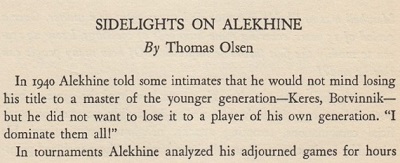

The next step is to verify that the quote is indeed in the magazine CHESS. Below is the relevant part of the May 1946 edition (pages 169-172):
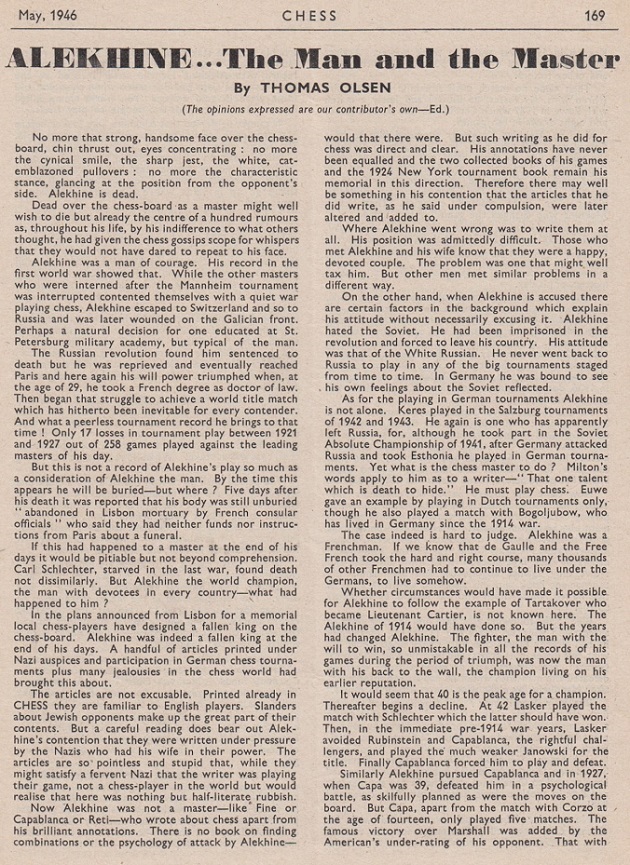
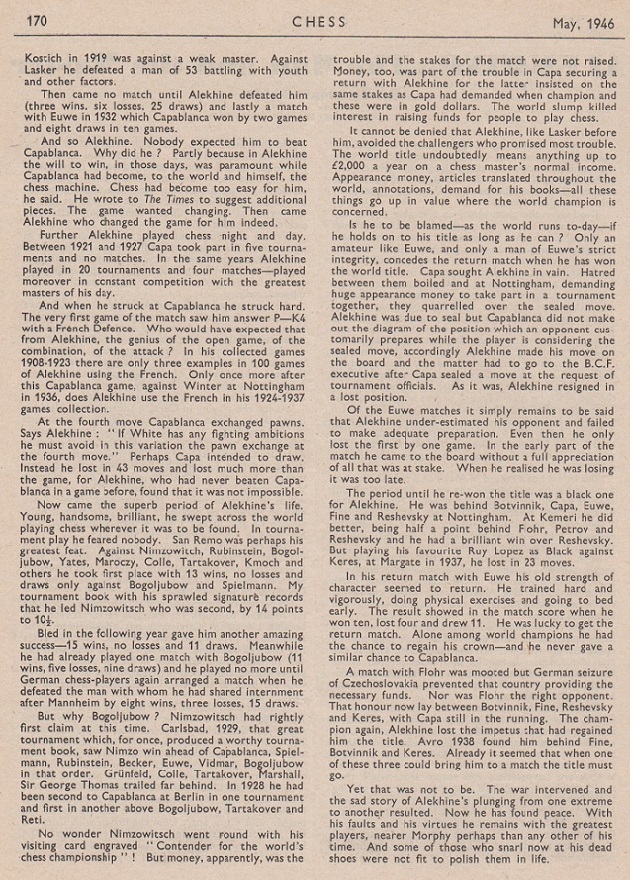

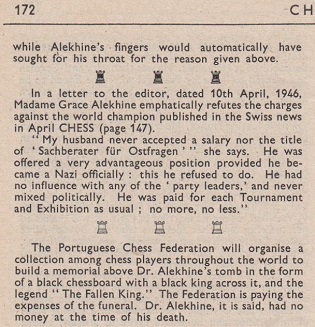
However, if Thomas Olsen were the evident answer to our poser, C.N. 8947 would not have described the question as ‘exceptionally difficult’.
Page 198 of the June 1946 CHESS stated:
‘ALEKHINE NOTES
(continued)In the May number of CHESS owing to a technical mistake the above title was omitted from the top of page 171. Mr Thomas Olsen’s article “Alekhine ... The Man and the Master” finishes with page 170, and the notes which follow are not from his pen.’
Consequently, Reinfeld’s later attributions to Olsen are incorrect, as is the reference in C.N. 7209 to ‘a three-page feature “Alekhine ... The Man and the Master” by Thomas Olsen’.
It is now tempting to assume that the writer of the remaining Alekhine material in the May 1946 CHESS was the magazine’s editor, B.H. Wood, but that is not so. Page 44 of the 12 November 1955 CHESS carried a review of Reinfeld’s The Treasury of Chess Lore which included this correction:
‘There are several quotations from CHESS; one of these (page 197), probably through our not making the authorship clear ourselves, is ascribed to Thomas Olsen instead of B. Reilly.’
How much unsigned material Brian Reilly wrote for CHESS naturally cannot be known, but in the mid-1940s he was indeed working for the magazine, as he informed W.H. Cozens on page 360 of the September 1981 BCM.
8951. Thomas Olsen (C.N.s 7209 & 8950)
Biographical information on Thomas Olsen is still being sought. As mentioned in C.N. 824 (see Chess and Sleep), he wrote an article entitled ‘Capablanca – and Some Others’ in CHESS, 14 November 1938 (pages 85-87). The heading described him as ‘Chess leader-writer for the News Chronicle’. A few extracts:
– ‘A strange mixture, this Capablanca. Hot in temper and sincerity, icy-cold in the struggle of the chess-board and business affairs. Dapper, careful in choice of shirts and ties. Hair, in early days, combed back carefully in a great bush above his forehead. Now, thinner, it is still brushed as carefully into place.
Chess? Self-complacent, satisfied, haughty – the now out-of-print My Chess Career is one of the most self-revelatory books ever penned by an unwitting author. Every line is so full of the most naive references to his own capabilities that one almost squirms as one reads.’
– ‘Paradoxical as it may sound, the greatest thing in the chess champion’s life was his loss of the title. This made him more human. Probably much of Capablanca’s self-esteem was psychologically due to the frustrations he suffered in his efforts to get a match with Lasker. Once that was granted and he had won, he could rest himself. The trouble was that he now relaxed too much, too confident in his powers. He came to the New York tournament of 1924 in bad chess shape.’
– ‘After the loss of his title, Capablanca’s popularity undoubtedly increased. He is a different man today from the man of My Chess Career. It is doubtful if he would ever consent to that book’s reappearance in first edition form. In England he is very popular indeed – perhaps the most popular of all the masters, except Tartakower.
Alekhine, on the other hand, is wrongly considered by some chessplayers austere and aloof. As a personal acquaintance of the world champion I can only say this is a totally incorrect idea. He is a most approachable and friendly man and his wife a very charming lady. One well-known young English player of the highest class told me how, after he had lost to Dr Alekhine, the Doctor in a modest way offered to play the game over again with him privately and went into extended analysis and discussion.’
The remainder of the article concerned the future of the world championship, including Olsen’s belief that it was necessary to ‘put the world championship title into the hands of the International Federation’.
8952. Chess columns
From an article ‘Our Penmen and Pressmen’ by ‘N.R.W.’ on pages 4-6 of the January 1867 issue of the Chess Player’s Magazine:
‘If chess be worth half the love and time that have been lavished upon it, it surely deserves not merely study in the matter of its science but intelligence and zeal in the setting forth of everything that belongs to it besides. A chess column in a weekly paper ought not to be a lumber corner where a budget is opened at haphazard, and the contents are loosely scattered about. It should be the neatest and most inviting division of all.’
8953. Reshevsky’s determination
‘Perhaps no other chess master has ever approached Sammy Reshevsky when it comes to determination. He’s the hardest fighter of them all. Any position is grist to his mill. He is at his best when he gets the assignment to make something out of nothing. To him “dull” positions don’t exist. If he thinks about it long enough, he’s sure to find an angle. Once he gets that far, he has a won game before his opponent quite knows what it’s all about.
Because Reshevsky can almost hear the grass grow, he can spot microscopic advantages. They’re enough for him to work on. Slowly, slowly, and with the greatest patience in the world, he builds up the advantage, strengthens his position, gets his striking forces into action, and hits hard. No-one is his superior in the art of applying slow torture on the chessboard.’
Source: page 49 of How to Play Chess Like a Champion by Fred Reinfeld (New York, 1956).
From one of our copies of The Art of Positional Play by Samuel Reshevsky (New York, 1976):
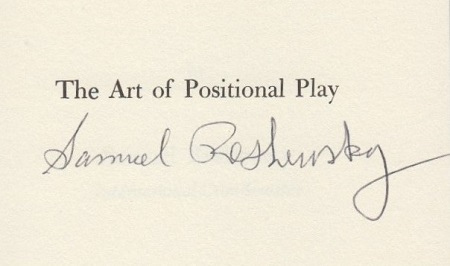
8954. 1 e4 (C.N. 7852)
C.N. 7852 quoted from page 8 of Curious Chess Facts by Irving Chernev (New York, 1937):
‘Ern[e]st Grünfeld, probably the greatest living authority on the openings, played 1 P-K4 only once in his whole tournament career (against Capablanca, Carlsbad, 1929). When asked why he avoided 1 P-K4 he replied, “I never make a mistake in the opening”.’
The source of the alleged Grünfeld remark was requested, and we can now add an older citation (with the words ‘by accident’), although not from a primary source:
‘His serious outlook on the game is illustrated by his naive reply to the query of another chess master, as to whether he ever, by accident, had played P-K4 on the first move, “I never make a mistake in the opening”.’
Source: page 51 of Modern Master-Play by F.D. Yates and W. Winter (London, 1929).

8955. Queen’s knight’s pawn (C.N.s 5827, 5865, 6021, 6669, 6829 & 8289)
From page 7 of Modern Master-Play by F.D. Yates and W. Winter (London, 1929):
‘A story is told of a chess enthusiast of the middle of the last century who willed his son £1,000 per annum on condition that he never took the QKtP ...’
8956. Who?
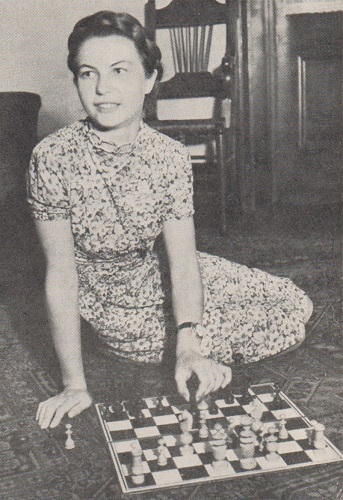
8957. Rich As A King
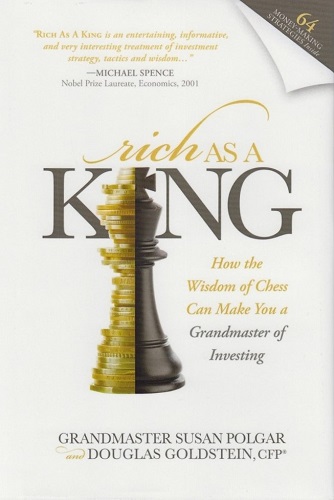
One of the many disagreeable conclusions to be drawn from Rich As A King by Susan Polgar and Douglas Goldstein (New York, 2015) is that Susan Polgar is interested in the great players of the past solely as name-dropping fodder. Hackneyed stories and quotes are crowbarred in (without any source, naturally) to explain, so the dust-jacket promises, ‘the specific tactics that you can apply right now to turn your bank, brokerage, and retirement accounts into a grandmaster portfolio’.
Even when a quote is sound, the financial counsel tagged on may be shallow and inapposite. From page 103:

On page 229 a quote attributed to Lasker’s impoverished predecessor somehow prompts further platitudinous advice:
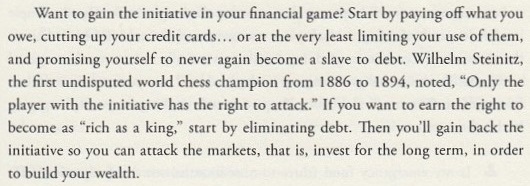
The chess content is of the Pandolfini ‘once’ type. From page 209:
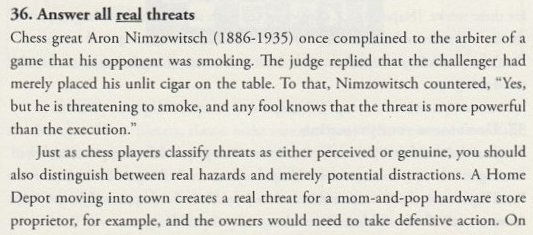
More ‘once’ stuff is on page 22:
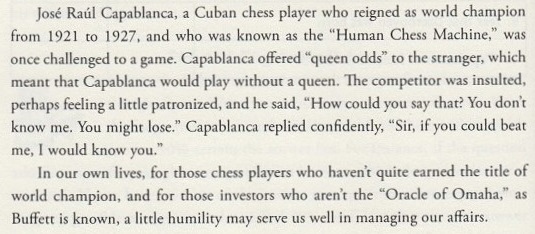
Humility advocated in a book by Susan Polgar? That is rich.
8958. Scientist/monk/beast of prey (C.N.s 6587, 6596 & 8138)
From page 185 of Rich As A King by Susan Polgar and Douglas Goldstein (C.N. 8957):
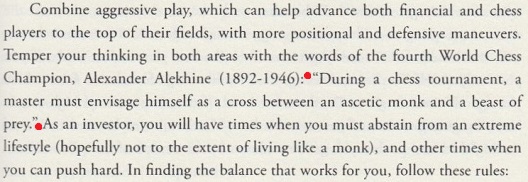
The alleged Alekhine quote has been discussed in C.N.s 6587, 6596 and 8138, and below is a chronological compilation of the occurrences already noted, together with a few additional ones:
- ‘Botvinnik is in the greatest tradition of world champions, with Morphy, Lasker, Capablanca and Alekhine. Playing him, one gets a strong sense of someone dedicated to the game – a mixture of monk and scientist.’
Page 611 of The Listener, 16 August 1958 (article by C.H.O’D. Alexander).
- ‘Alekhine himself lost his title as a drunk but regained it when he followed his own advice to live like an ascetic monk.’
Page 29 of CHESS, September 1988 (article by Nigel Davies).
- ‘Alekhine was once quoted as saying that the successful tournament player must combine the chief characteristics of a research scientist, an ascetic monk and a beast of prey.’
Page 8 of Blunders and Brilliancies by Ian Mullen and Moe Moss (Oxford, 1990).
- ‘“During a chess competition a chess master should be a combination of a beast of prey and a monk.” – Alexander Alekhine.’
Page 11 of Essential Chess Quotations by John C. Knudsen (Falls Church, 1998).
- ‘“During a chess competition a chessmaster should be a combination of a beast of prey and a monk.” Alexander Alekhine.’
Page 88 of Treasure Chess by Bruce Pandolfini (New York, 2007).
- ‘Alexander Alekhine was once quoted as saying, in summing up the situation, that the successful tournament player “must combine the chief characteristics of a research scientist, an ascetic monk and a beast of prey”.’
Page 139 of Counterplay by Robert Desjarlais (Berkeley and Los Angeles, 2011). An endnote on page 233 merely mentioned as the source the 1990 Mullen/Moss book.
- ‘Of course chess and chess problems are quite different. The former has been called a sport, an art form, a beautiful mistress, something for which life is not long enough, and a game in which one must envisage oneself as a cross between an ascetic monk and a beast of prey.’
Page 26 of Vladimir Nabokov A Literary Life by David Rampton (Basingstoke, 2012).
- ‘Temper your thinking in both areas with the words of the fourth World Chess Champion, Alexander Alekhine (1892-1946): “During a chess tournament, a master must envisage himself as a cross between an ascetic monk and a beast of prey.”’
Page 185 of Rich As A King by Susan Polgar and Douglas Goldstein (New York, 2015).
In short, with regard to Alekhine there has been no primary source, or recognition that, without one, any version of the quote is pointless and unusable.
8959. 3...Bb4 not even mentioned
On the pitifully poor Rich As A King we conclude by showing one full sample page which speaks for itself:
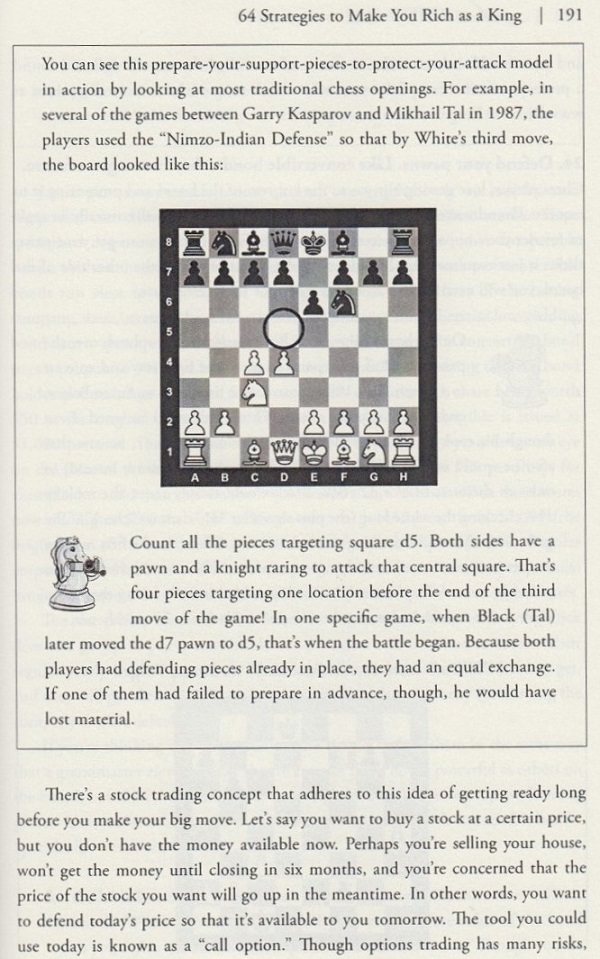
8960. British newspaper reports of the 1920s and 30s
Olimpiu G. Urcan (Singapore) has found the cuttings presented below:
- R. Réti (1923):
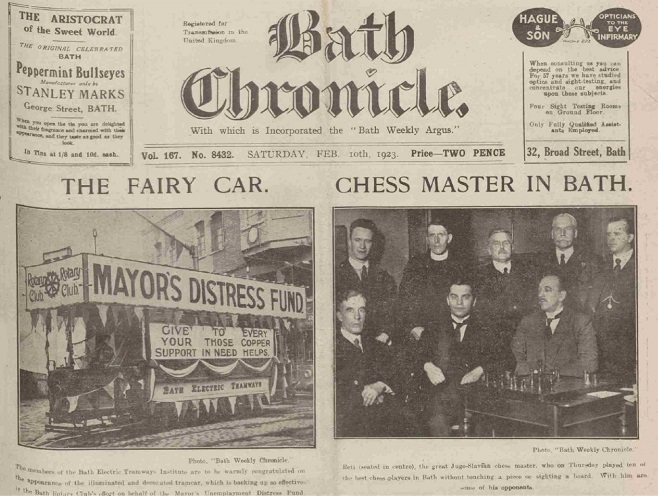
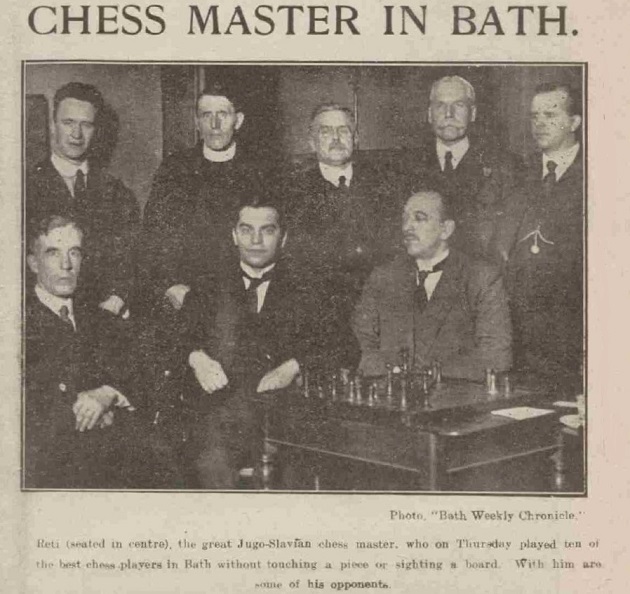
Bath Chronicle, 10 February 1923, page 1.
- G. Maróczy (1924):
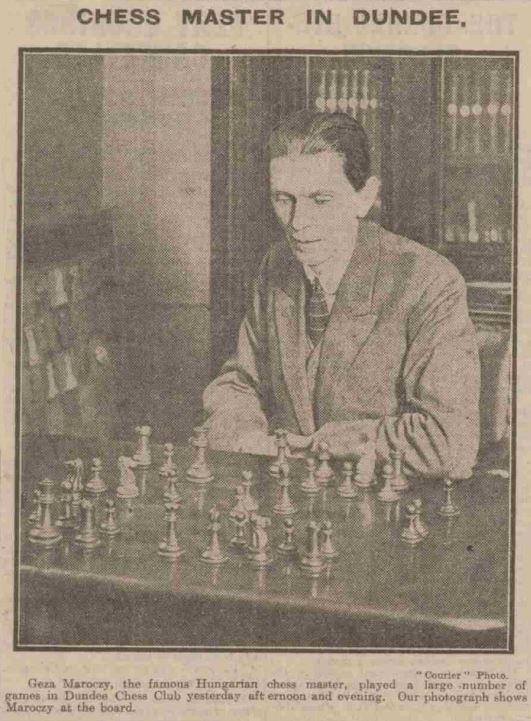
- R. Réti (1927):
From the Burnley Express of 23 April 1927 (page 3), 30 April 1927 (page 11) and 4 May 1927 (page 5) come reports of a 21-board simultaneous display, including three games which Mr Urcan has transcribed (diffidently in view of the newspaper’s imperfect use of the descriptive notation):
John Robinson – Richard Réti
Burnley, 26 April 1927
Four Knights’ Game
1 e4 e5 2 Nf3 Nc6 3 Nc3 Nf6 4 Bc4 Bb4 5 d3 d5 6 exd5 Nxd5 7 Bxd5 Qxd5 8 Bd2 Bxc3 9 Bxc3 O-O 10 O-O Bg4 11 Re1 Rfd8 12 Qe2 f6 13 Qe4 Qxe4 14 Rxe4 Bxf3 15 gxf3 Kf7 16 Rg4 h5 17 Rg2 Nd4 18 Bxd4 Rxd4 19 Kf1 Rad8 20 Rd1 c5 21 Ke2 b5 22 Rh1 Rh4 23 Rg3 Rdd4 24 c3 Rdf4 25 a3 c4 26 dxc4 bxc4 27 b4 Rf5 28 h3 Rhf4 29 h4 e4 30 Rhh3 exf3+ 31 Rxf3 Rxf3 32 Rxf3 Rxf3 33 Kxf3 g5 34 hxg5 fxg5 35 Kg3 Kf6 36 Kf3 Ke6 37 Ke4 Kf6 38 Kf3 Ke5 39 Kg3 Kf6 40 f3 Ke6 41 f4 h4+ 42 Kg4 h3 43 Kxh3 gxf4 44 Kg2 Ke5 45 Kf3 Kf5 46 a4 Ke5 47 a5 Resigns.
Richard Réti – A.A. Bellingham
Burnley, 26 April 1927
King’s Gambit Accepted
1 e4 e5 2 f4 exf4 3 Qf3 Qh4+ 4 g3 Qf6 5 Nc3 Nc6 6 Nd5 Qd8 7 gxf4 Nf6 8 Nxf6+ Qxf6 9 c3 h5 10 d4 d6 11 f5 Qh4+ 12 Kd1 g5 13 Bd3 Bh6 14 Qg3 Bd7 15 Qxh4 gxh4 16 Bxh6 Rxh6 17 Nf3 O-O-O 18 Rg1 Ne7 19 Ke2 Ng8 20 Rg7 Rf8 21 Rag1 Nf6 22 h3 Rhh8 23 Nxh4 Ne8 24 R7g3 Nf6 25 c4 Re8 26 Ke3 c6 27 Kf4 b6 28 d5 c5 29 Nf3 h4 30 Rg7 Nh5+ 31 Ke3 Nxg7 32 Rxg7 Bxf5 33 Rxf7 Bxe4 34 Rf4 Drawn.
Walter Cole – Richard Réti
Burnley, 26 April 1927
Queen’s Indian Defence
1 d4 Nf6 2 Nf3 e6 3 Nbd2 b6 4 e3 Bb7 5 Be2 c5 6 c3 cxd4 7 cxd4 Be7 8 O-O O-O 9 b3 d5 10 Bb2 Nbd7 11 Bd3 Rc8 12 Rc1 Bd6 13 Qe2 Qe7 14 Ne5 Ba3 15 Nb1 Bxb2 16 Qxb2 Nxe5 17 dxe5 Nd7 18 Nd2 f6 19 exf6 gxf6 20 f4 Rf7 21 Nf3 Nc5 22 Bb1 Kh8 23 b4 Ne4 24 Rxc8+ Bxc8 25 Bxe4 dxe4 26 Nd4 Rg7 27 Nc6 Qf7 28 Qd4 Qg6 29 Rf2 Rd7 30 Qa1 Rd3 31 Qe1 Qh5 32 Rd2 Qb5 33 Rc2 Ba6 34 Nd4 Qa4 35 Rc1 Qd7 36 Qh4 Qd8 37 Qf2 Bc4 38 h3 b5 Drawn.
- F.J. Marshall and Sir George Thomas (1927):

Dundee Evening Telegraph, 11 October 1927, page 1.
- E. Znosko-Borovsky (1932):

Dundee Courier, 16 November 1932, page 8.
- E. Eliskases (1933):
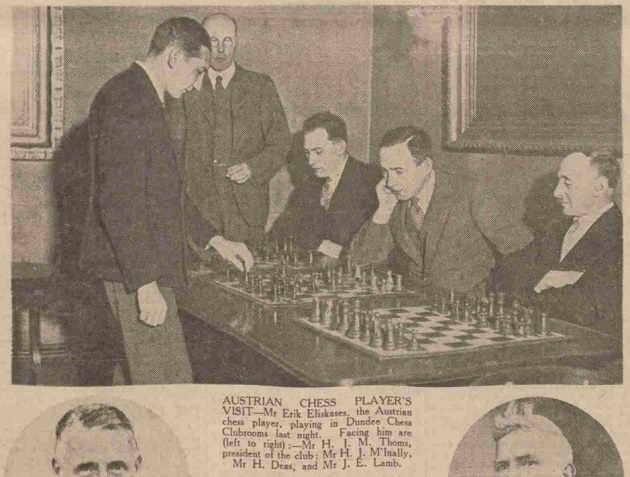
Dundee Courier, 15 November 1933, page 8.
- S. Graf (1935):
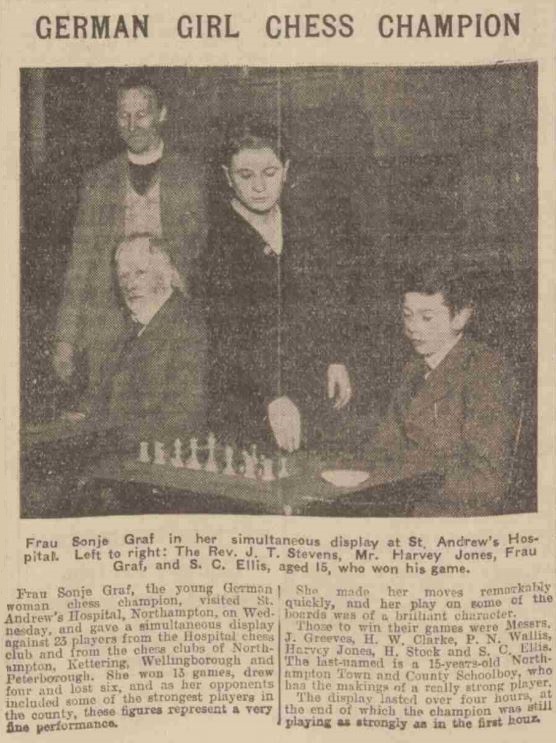
Northampton Mercury, 5 April 1935, page 7.
- E. Znosko-Borovsky (1936):
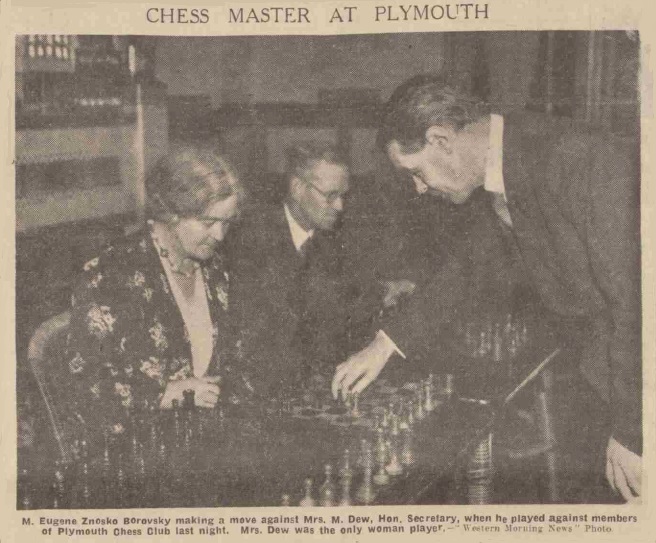


Western Morning News and Daily Gazette, 20 November 1936, page 7.
- G. Koltanowski (1937):
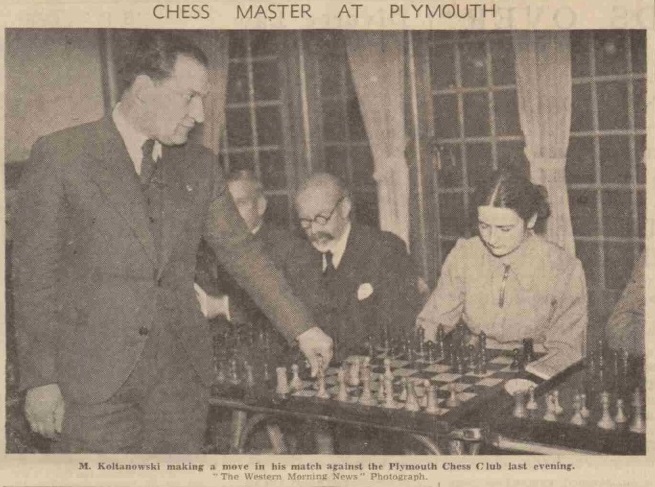
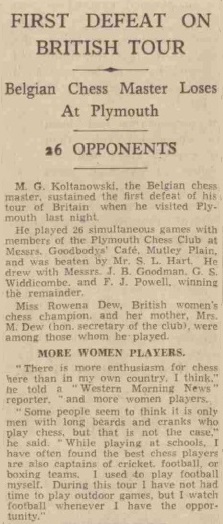
Western Morning News and Daily Gazette, 26 November 1937, page 8.
- Sir George Thomas (1938):
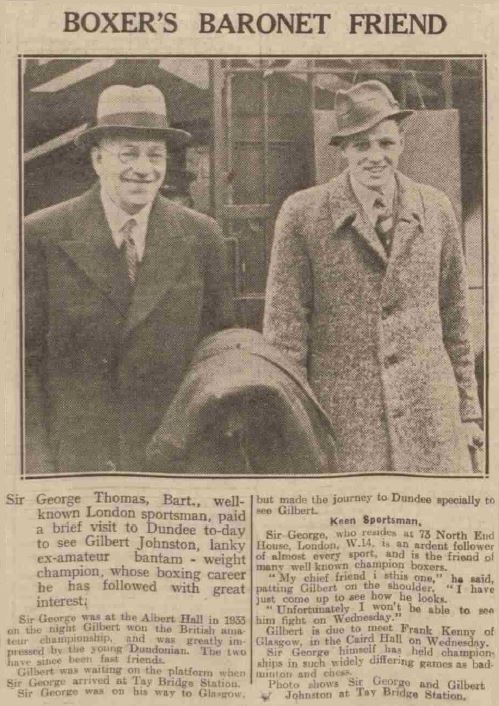
Dundee Evening Telegraph, 20 January 1938, page 1.
8961. Wildhagen books
Erik Osbun (El Centro, CA, USA) asks why two of the four planned volumes on Soviet chess in Wildhagen’s Weltgeschichte des Schachs series (Hamburg) were never published.
We note that many of the projected tomes did not materialize, including volume one [sic] of an intended two-book set on Yugoslav chess. Below is a chronological list of the works that were published:
- 11: Lasker by L. Rellstab (1958)
- 23: Botwinnik by M. Botwinnik (1959)
- 18: Euwe by M. Euwe (1959)
- 21: Keres by P. Keres (1960)
- 33: Sowjetisches Schach I (1917-35) by A. Kotow and S. Flohr (1960)
- 9: Tschigorin by L. Abramow (1960)
- 25: Tal by M. Tal (1961)
- 24: Unzicker by W. Unzicker (1962)
- 14: Capablanca by J. Gilchrist and D. Hooper (1963)
- 26: Petrosjan by T. Petrosjan (1963)
- 36: Sowjetisches Schach IV (1953-60) by P. Keres (1963)
- 41: Das Interzonenturnier Amsterdam 1964 (two volumes) by S. Flohr and M. Euwe (1965)
- 38: Jugoslawisches Schach II by P. Trifunović (1965)
- 6: Morphy-Paulsen by L. Rellstab (1967)
- 4: Anderssen I by G. Pollak (1968)
- 7: Steinitz by D. Hooper (1968)
- 27: Spassky by A.S. Liwschitz (1972).
We have two slightly different editions of the Spassky volume, and the penultimate page of one of them gives further information about the publisher’s output, actual and intended:
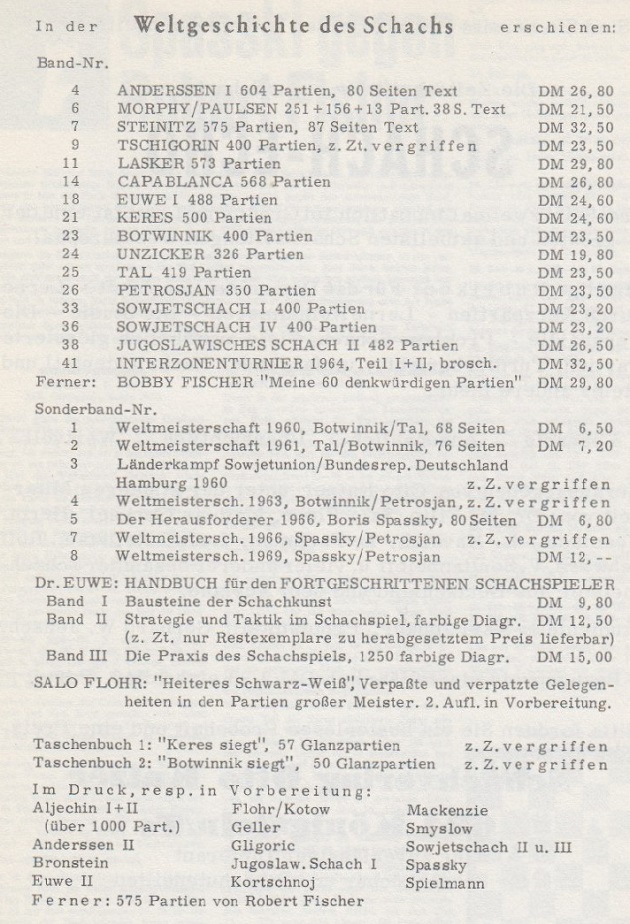
Apart from, of course, the planned book on the 1969 world championship match, the same list had been in the 1968 volumes on Anderssen and Steinitz. The publisher, Eduard Wildhagen, died in 1977.
8962. The ‘big red book’
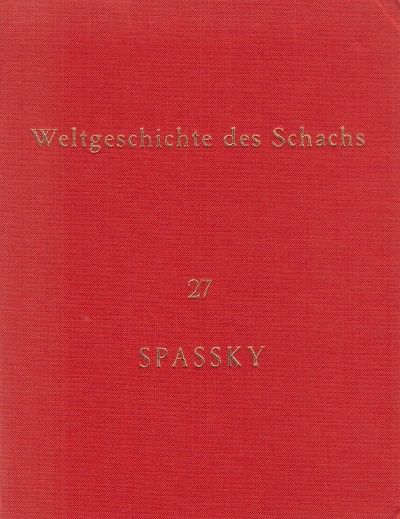
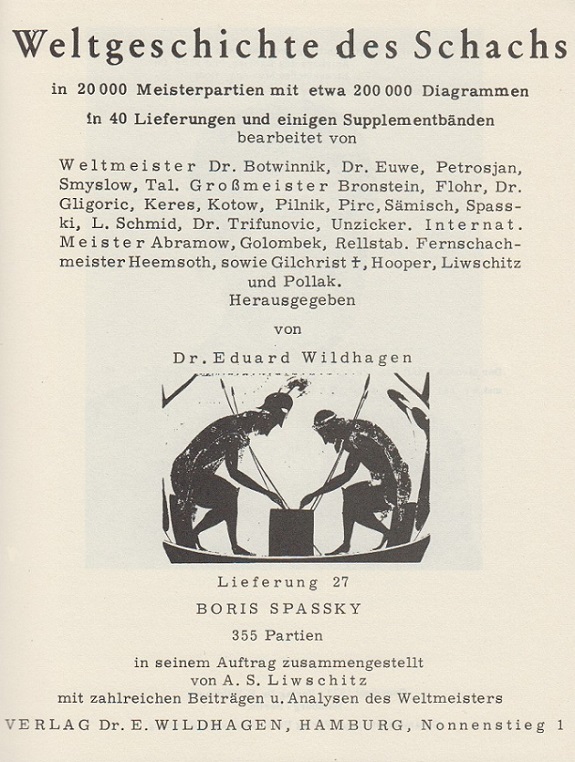
Little is known about A.S. Liwschitz (Livshits), although his 1972 volume on Spassky was, for a time, the most famous chess book in the world. Below, for instance, is part of an article on page 25 of the New York Times, 1 April 1972:
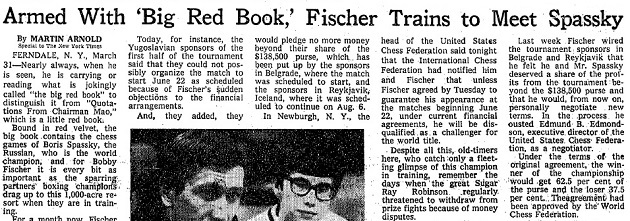
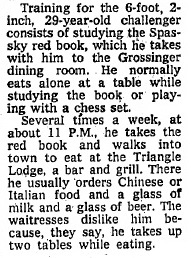
The photograph below comes from page 189 of Bobby Fischers vej til VM by Jens Enevoldsen (Copenhagen, 1972):
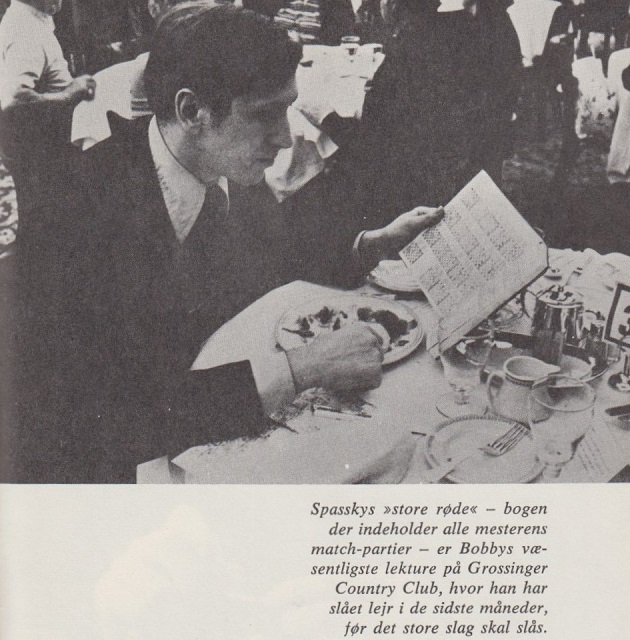
8963. Correspondence chess trick (C.N. 8942)
The request at the end of C.N. 8942 has been answered by the Cleveland Public Library, which has provided the following from page 22 of the February 1961 Ohio Chess Bulletin (Editor: David G. Wolford):

We now note an earlier report of the trick. On page 130 of the June 1941 CHESS a reader, J. Jackson of Caldbeck, wrote:
‘... in a recent match between Eire and Ulster, one of the Papists, at a highish board, opened with 1 P-Q4; his opponent replied: “1...P-KKt3; 2 Any, B-Kt2” and resigned on receipt of the laconic answer: “2 B-R6 ... 3 BxB”.’
In the electronic age a parallel may be drawn with ‘pre-moving’. See, for example, chapters four and five of Bullet Chess One Minute to Mate by H. Nakamura and B. Harper (Milford, 2009).
8964. Alekhine on Euwe
It is difficult to know what to make of Alekhine’s remark in brackets at the end of a letter published on page 161 of the August 1941 CHESS:
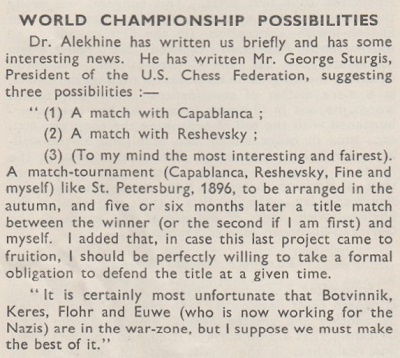
8965. Who?
A very well-known master:

8966. Who? (C.N. 8965)
From a second picture it is even possible to deduce the exact date on which both photographs were taken:
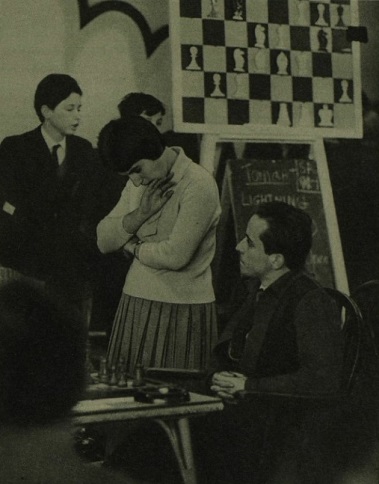
8967. A.G. Laing (C.N.s 8728, 8762 & 8877)
Below is another game from the score-books of A.G. Laing. It was played shortly before Mieses’s 77th birthday:
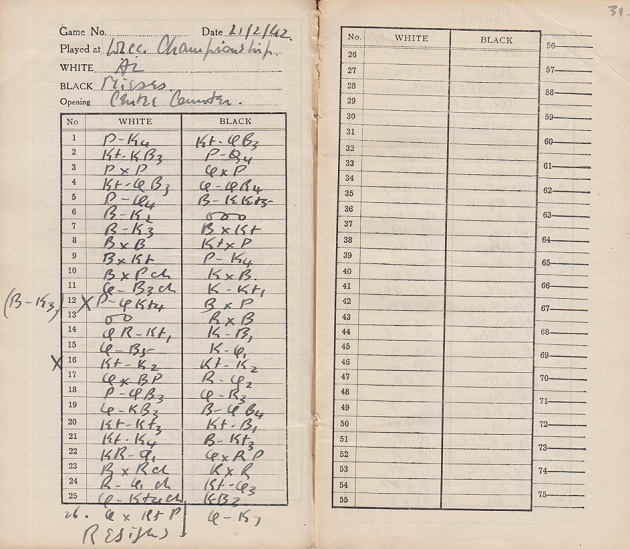
A.G. Laing – Jacques Mieses
London, 21 February 1942
Centre Counter Game
1 e4 Nc6 2 Nf3 d5 3 exd5 Qxd5 4 Nc3 Qa5 5 d4 Bg4 6 Be2 O-O-O 7 Be3 Bxf3 8 Bxf3 Nxd4 9 Bxd4 e5 10 Bxb7+ Kxb7 11 Qf3+ Kb8
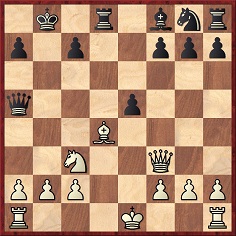
12 b4 Bxb4 13 O-O Rxd4 14 Rab1 Kc8 15 Qf5+ Kd8 16 Ne2 Ne7 17 Qxf7 Rd7 18 c3 Qa6 19 Qf3 Bc5 20 Ng3 Nc8 21 Ne4 Bb6 22 Rfd1 Qxa2 23 Rxd7+ Kxd7 24 Rd1+ Nd6 25 Qg4+ Kc6 26 Qxg7 Qe2 27 White resigns.
8968. Paul Morphy and Queen Victoria
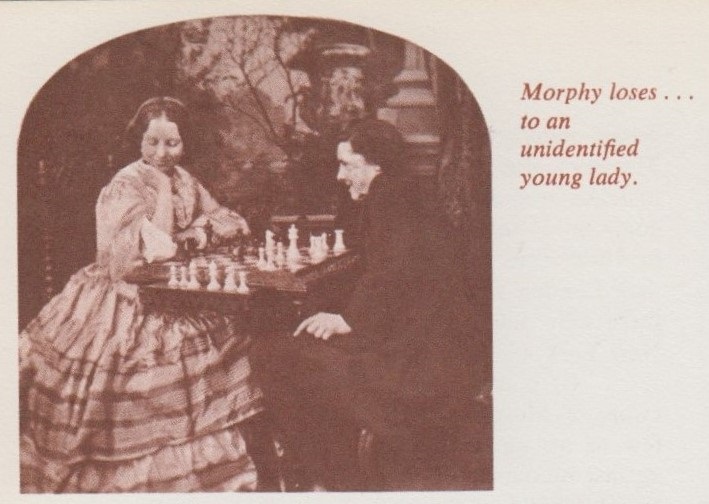
This photograph comes from page 40 of Chessworld, January-February 1964, in an article on Morphy by David Lawson. One of two similar shots, it was also given (‘Paul Morphy and a lady’) on page 333 of Lawson’s 1976 biography of Morphy. Page 109 showed the same setting in a photograph of Morphy and Löwenthal (‘London, 1858’).
Even so, page 94 of Arte y Ajedrez by Gabriel Mario Gómez (Buenos Aires, 2014) bizarrely asserts that the photograph was taken in the gardens of Buckingham Palace and that Morphy’s opponent was Queen Victoria:

Chess and British Royalty notes a discussion of Morphy and Queen Victoria on pages 200-201 of Lawson’s book, which included this passage:

Can a reader provide the full text of that newspaper
report?
8969. Gómez
As mentioned in C.N. 2765 (see Chess Jottings), an earlier book by Gabriel Mario Gómez, Historia del ajedrez (Buenos Aires, 1998), had this on page 160:
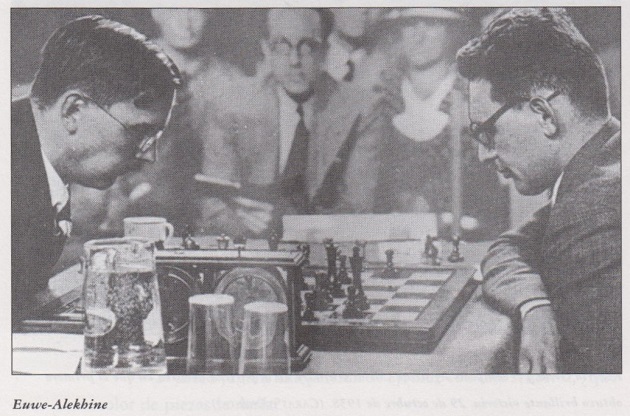
8970. Domination
(C.N.s 7209 & 8950)
C.N.s 7209 and 8950 showed the earliest known appearance of a famous remark ascribed to Alekhine, ‘I dominate them all’ (page 171 of the May 1946 CHESS):

This second-hand version related to unnamed third parties is often reduced to a general boast by Alekhine, as in this ‘once’ version on page 251 of The Golden Dozen by Irving Chernev (Oxford, 1976):
‘Alekhine played chess as if his life depended on it. He had to win, win, win, and live up to what he once said, “I dominate them all!”’
The phrase was used to advertise Al Horowitz’s New York Times column on page 233 of the April 1972 Chess Life & Review:

Another occurrence is on the back cover of the Dover edition of Fred Reinfeld’s collection 100 Instructive Games of Alekhine (New York, 1959):
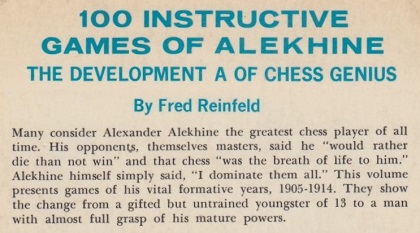
The quote also stood alone in the heading (page 168) of the Alekhine chapter in Reinfeld’s The Great Chess Masters and Their Games (New York, 1952):

Reinfeld amplified on page 189:
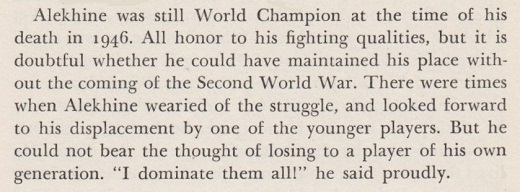
8971. ‘Chess has been a minor factor in my life’
As reported in C.N. 95 (see pages 375-376 of Kings, Commoners and Knaves) Alekhine stated in an interview, ‘Chess has been a minor factor in my life’. The full item to which C.N. 95 referred (Chess Review, January 1945, page 13) is shown here:
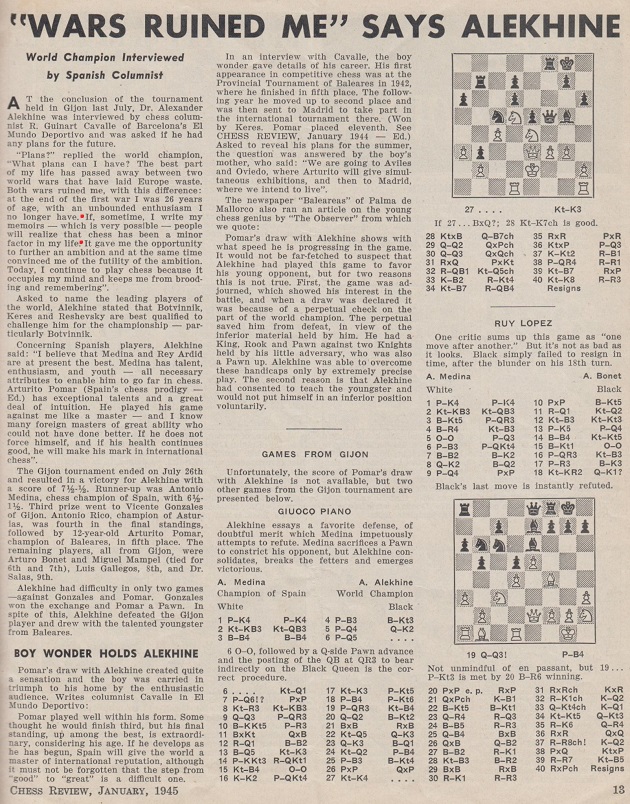
However, a footnote on page xiii of A. Alekhine Agony of a Chess Genius by Pablo Morán (Jefferson, 1989) stated that the interview came from the Gijón daily newspaper El Comercio of 22 July 1944 and was conducted by Juan Fernández Rúa (and not, as indicated in the first paragraph of the Chess Review article, by Ricardo Guinart Cavallé in El Mundo Deportivo).
Can the original Spanish-language interview be found?
8972. 2 Bg5
C.N. 5261 (see The Trompowsky Opening) mentioned that pages 43-44 of Octávio Trompowsky’s 1941 book Partidas de Xadrez have a game which he played by telegraph in 1925 against José Montalbán (White). After 1 d4 d5 2 Bg5 Trompowsky wrote:
‘Uma fantasia interessante que Tartakower batizou de “Vôo no Azul” e que tem pelo menos o mérito de sair dos livros. Tarrasch disse algures que êste Bispo procurava pregar a sombra do Cavalo!’ [‘An interesting fantasy, which Tartakower christened a “Flight into the Blue” and which at least has the merit of leaving the books. Tarrasch said somewhere that this bishop was trying to pin the knight’s shadow!’]
Do readers have information about such a remark by Tarrasch, or by others? We can offer only a vague citation for the phrase on pages 234-236 of The Year-Book of Chess 1915 and 1916 by W.H. Watts and A.W. Foster (London, 1917). The game between R.H.V. Scott and T. Germann was played in 1915, in the 1915-16 City of London Chess Club Championship, and the notes were by Amos Burn in The Field.
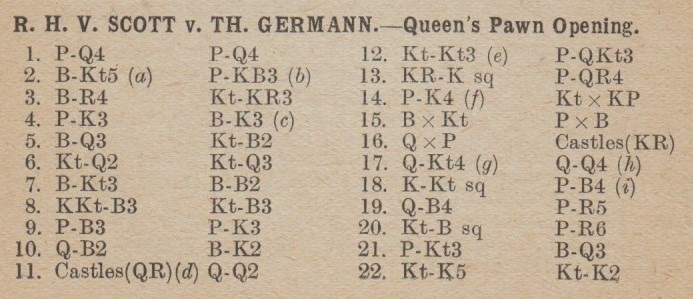
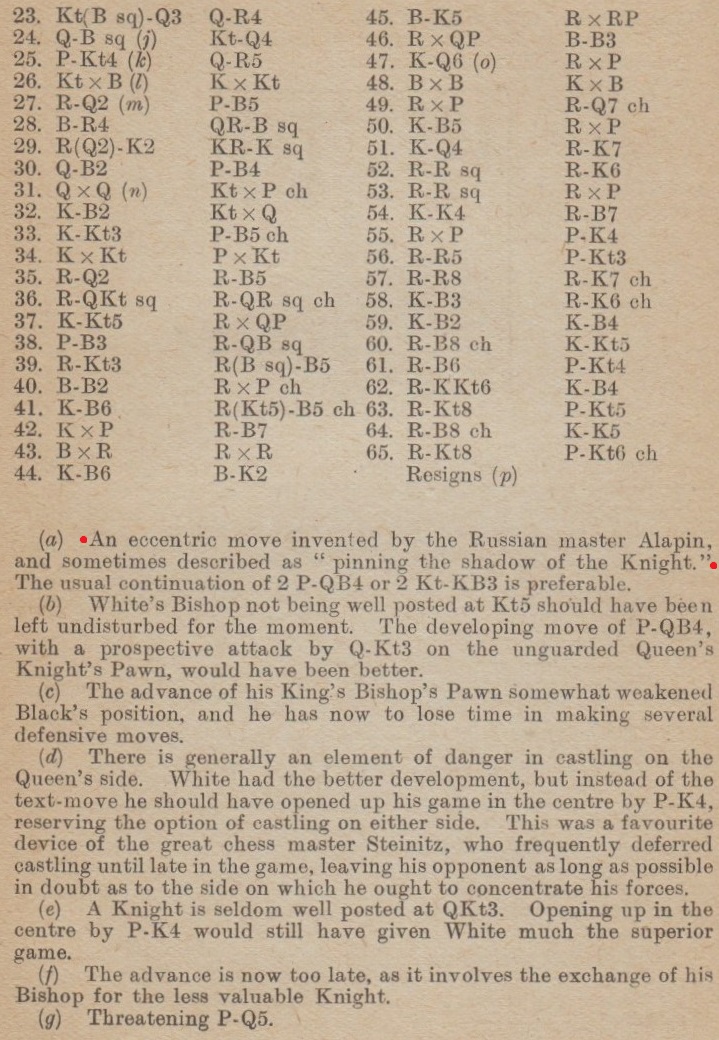
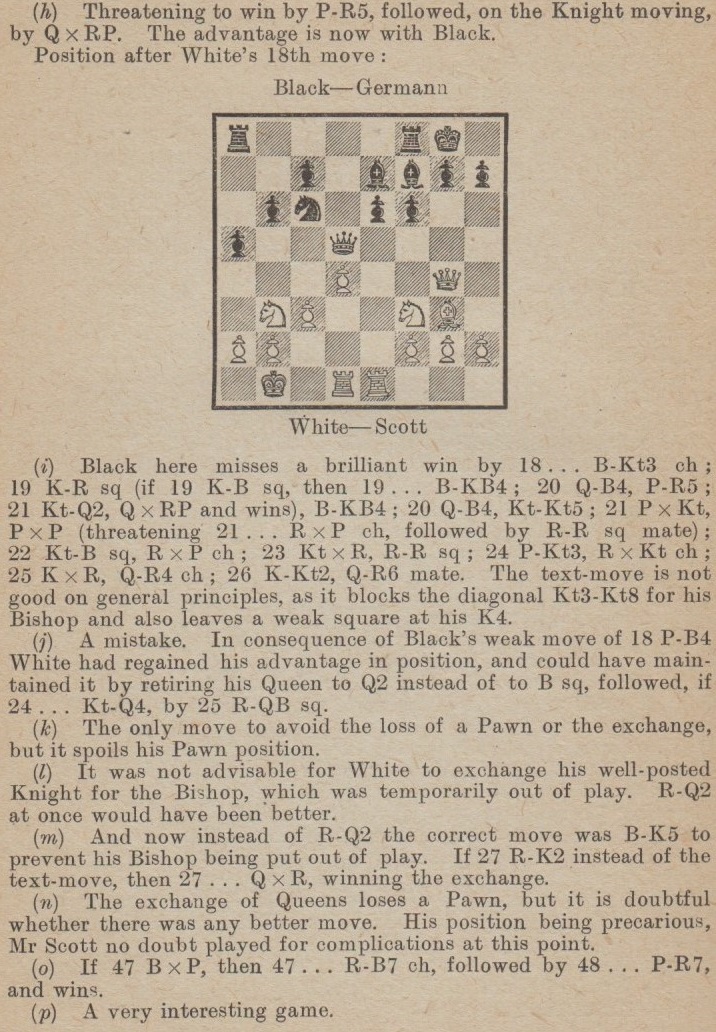
1 d4 d5 2 Bg5 f6 3 Bh4 Nh6 4 e3 Be6 5 Bd3 Nf7 6 Nd2 Nd6 7 Bg3 Bf7 8 Ngf3 Nc6 9 c3 e6 10 Qc2 Be7 11 O-O-O Qd7 12 Nb3 b6 13 Rhe1 a5 14 e4 Nxe4 15 Bxe4 dxe4 16 Qxe4 O-O 17 Qg4 Qd5 18 Kb1 f5 19 Qf4 a4 20 Nc1 a3 21 b3 Bd6 22 Ne5 Ne7 23 Ncd3 Qa5 24 Qc1 Nd5 25 b4 Qa4 26 Nxf7 Kxf7 27 Rd2 f4 28 Bh4 Rac8 29 Rde2 Rfe8 30 Qc2 c5 31 Qxa4 Nxc3+ 32 Kc2 Nxa4 33 Kb3 c4+ 34 Kxa4 cxd3 35 Rd2 Rc4 36 Rb1 Ra8+ 37 Kb5 Rxd4 38 f3 Rc8 39 Rb3 Rcc4 40 Bf2 Rxb4+ 41 Kc6 Rbc4+ 42 Kxb6 Rc2 43 Bxd4 Rxd2 44 Kc6 Be7 45 Be5 Rxa2 46 Rxd3 Bf6 47 Kd6 Rxg2 48 Bxf6 Kxf6 49 Rxa3 Rd2+ 50 Kc5 Rxh2 51 Kd4 Re2 52 Ra1 Re3 53 Rh1 Rxf3 54 Ke4 Rf2 55 Rxh7 e5 56 Rh5 g6 57 Rh8 Re2+ 58 Kf3 Re3+ 59 Kf2 Kf5 60 Rf8+ Kg4 61 Rf6 g5 62 Rg6 Kf5 63 Rg8 g4 64 Rf8+ Ke4 65 Rg8 g3+ 66 White resigns.
The Trompowsky Opening article notes that 2 Bg5 was frequently played by José Montalbán, and we add now that he even used it against Alekhine. The score below is taken from pages 59-60 of Ajedrez uruguayo (1880-1980) by Héctor Silva Nazzari (Montevideo, 2013):
José Montalbán – Alexander Alekhine
Montevideo, 27 October 1926
Trompowsky Opening
1 d4 Nf6 2 Bg5 c5 3 d5 Qb6 4 Bxf6 gxf6 5 Qc1
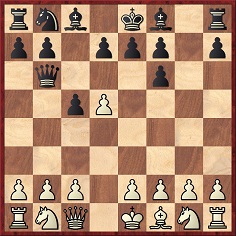
5...Bh6 6 e3 d6 7 c4 Bf5 8 Nc3 Nd7 9 f4 e5 10 g3 exf4 11 gxf4 O-O-O 12 Qd2 Qb4 13 Nb5 Qxd2+ 14 Kxd2 Nb6 15 Bd3 Bxd3 16 Kxd3 Rhg8 17 Ne2 a6 18 Nbc3 Rg6 19 Rhg1 Kd7 20 Ng3 Rdg8 21 Nce2 Nc8 22 Nf5 Bf8 23 Rg3 Ne7 24 Ke4 Nxf5 25 Kxf5 Ke7 26 Rag1 Rh8 27 Rh3 Bh6 28 Ng3 b5 29 Rc1 Kd7 30 b4 cxb4 31 cxb5 axb5 32 Ne4 Ra8 33 Rc6 Rxa2 34 Nxf6+ Kd8 35 Rxd6+ Kc8 36 Ne4 Bf8 37 Rxg6 fxg6+ 38 Ke6
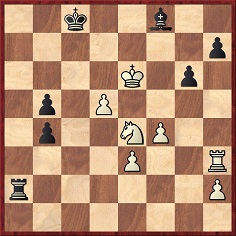
38...b3 39 Nc3 b2 40 d6 b4 41 Nb1 Ra1 42 e4 Bxd6 43 Rb3 Rxb1 44 e5 Kd8 45 h4 Ke8 46 h5 gxh5 47 White resigns.

Page 57 provides information on that first visit of Alekhine’s to Uruguay: +84 –7 =9 in four simultaneous displays, 11½ points out of 12 in six two-board sessions with clocks, a lecture and a blindfold display (score unknown). The circumstances of the game against Montalbán are not specified.
8973. Lasker in Montevideo
Another game from Ajedrez uruguayo (1880-1980), pages 46-47:
Emanuel Lasker – Alfredo Anaya
Simultaneous exhibition, Montevideo, 27 July 1910
Queen’s Gambit Declined
1 d4 d5 2 c4 e6 3 Nc3 Nf6 4 Bg5 Be7 5 e3 Nbd7 6 Qc2 O-O 7 Nf3 c6 8 Bd3 dxc4 9 Bxc4 Nd5 10 Bxe7 Qxe7 11 e4 N5b6 12 Bd3 e5 13 O-O exd4 14 Nxd4 Ne5 15 Rad1 Nxd3 16 Rxd3 c5 17 Nf3 Be6 18 Re1 Rfe8 19 h3 Rad8 20 Rde3 h6 21 a3 Nc4 22 R3e2 Qd7 23 Rd1 Qc6 24 Ne1 Rxd1 25 Qxd1 Qd7 26 Qxd7 Bxd7 27 f3 Bc6 28 Kf2 Rd8 29 Rc2 Rd2+ 30 Rxd2 Nxd2
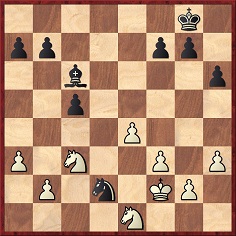
31 Nd3 Nc4 32 Nd1 b6 33 Ne3 Nxe3 34 Kxe3 f6 35 h4 g6 36 g4 Kf7 37 g5 hxg5 38 hxg5 Bb5 39 gxf6 Kxf6 40 Nf2 Bd7 41 f4 a6 42 Nd3 Be6 43 b4 cxb4 44 Nxb4 a5 45 Nd5+ Bxd5 46 exd5 Ke7 47 a4 Kd6 48 Kd4 b5 49 axb5 a4 50 b6 a3 51 Kc3 Kxd5 52 b7 Resigns.
8974. Who? (C.N.s 8965 & 8966)


The chess master in C.N. 8974 is Florin Gheorghiu. In the second photograph (C.N. 8975), which includes Nona Gaprindashvili, the position on the demonstration board can be identified as coming from Keres v Hindle, Hastings, 1964-65. The tournament report on page 37 of the February 1965 BCM indicates regarding that fifth round, played on 1 January 1965, that Gheorghiu’s opponent was Norman Littlewood.
The photographs come from a feature on pages 30-31 of the Illustrated London News, 9 January 1965 which has been supplied by Olimpiu G. Urcan (Singapore):
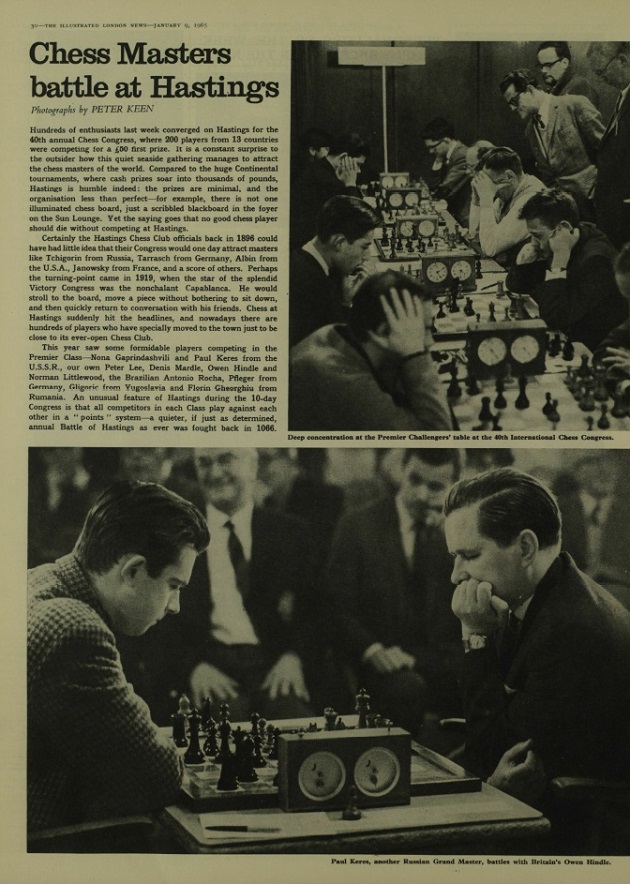
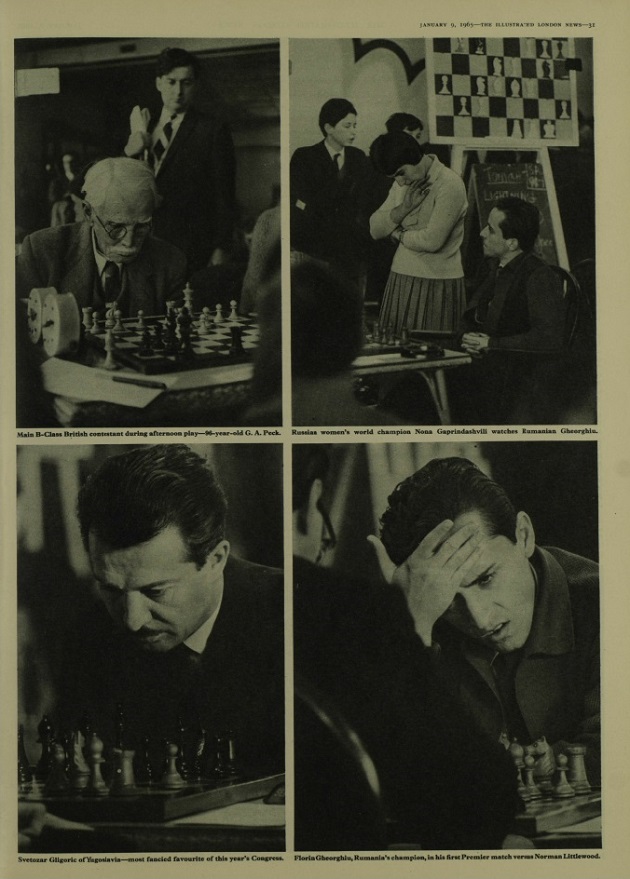
8975. Ströbeck, Taimanov v Ólafsson, and the Gambit Chess Rooms
Mr Urcan has also forwarded page 231 of the Illustrated London News, 12 August 1905:
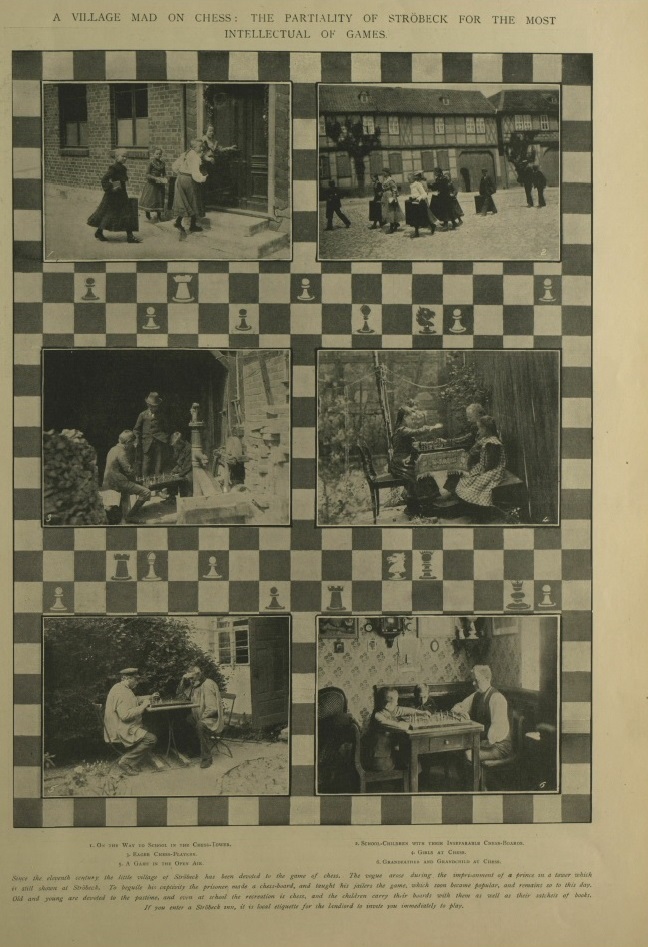
The photograph below (Mark Taimanov in play against Friðrik Ólafsson, Hastings, 28 December 1955) is from page 31 of the Illustrated London News, 7 January 1956:

Finally, our correspondent has provided a
report about the Gambit Chess Rooms, London on pages
23-25 of Picture Post, 12 January 1946:
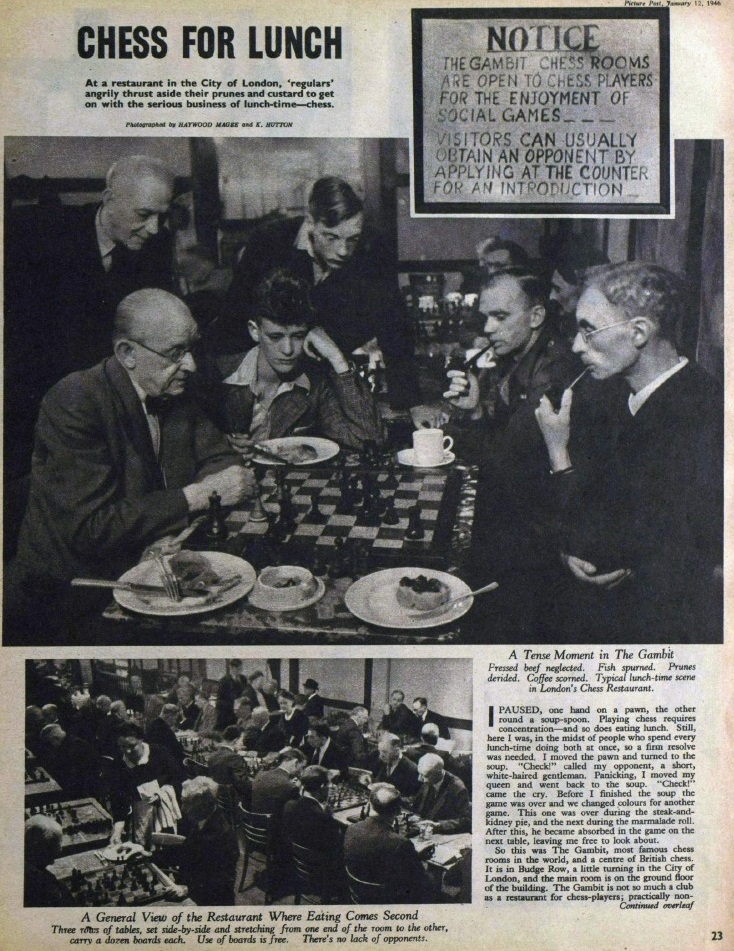

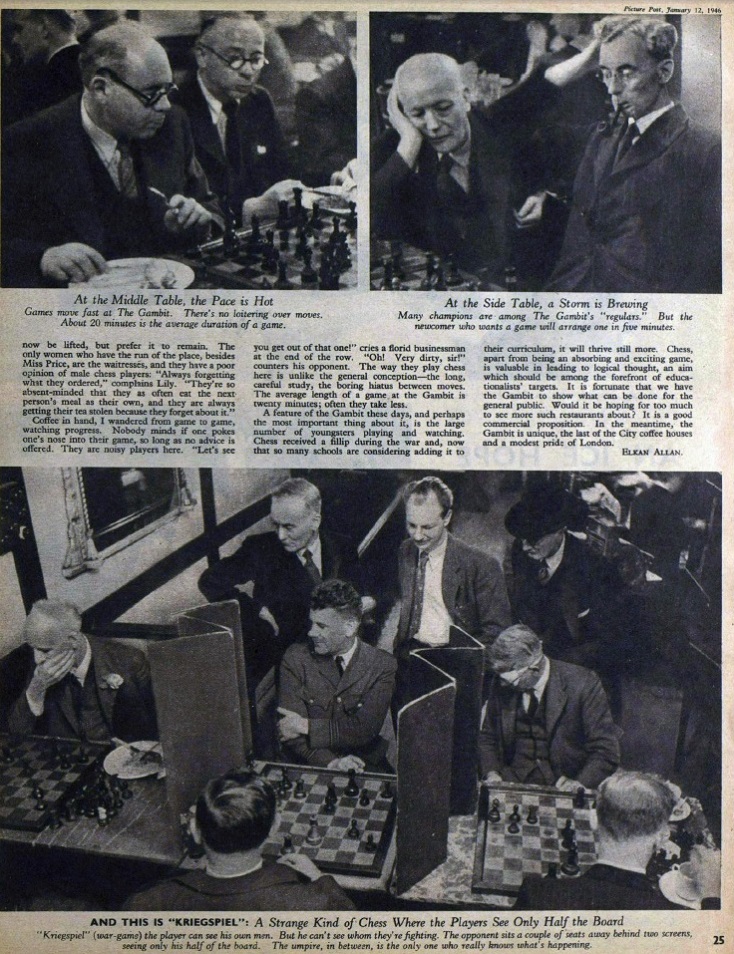
8976. ‘One of the finest combinations ever played’
‘One of the finest combinations ever played’, commented Fred Reinfeld on page 137 of Creative Chess (New York, 1959), a book reissued after his death as Chess Secrets Revealed:
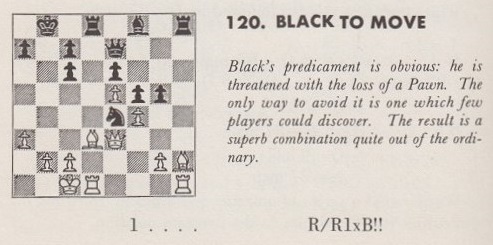

No particulars about the players or occasion were mentioned, and page 143 of The Fireside Book of Chess by I. Chernev and F. Reinfeld (New York, 1949) had merely described the conclusion as ‘a brilliant combination from a game played in 1935’.
The finish has been widely quoted in chess literature as from Andreiev/Andreyev/Andreev v Dolookhanow/Dolookhanov/Dolukhanov/Dolukanov, Leningrad, 1935. It was given on pages 72-73 of The Middle Game in Chess by E. Znosko-Borovsky (London, 1938), and the translator of that book, J. du Mont, showed it on page 6 of The Basis of Combination in Chess (London, 1938). Neither work offered analysis, and we have never traced the full game (including information on what happened after 6...Nxd1+) or details about the players and occasion.
On the analytical front, the position was touched upon on
pages 238-239 of Chess Life & Review, April
1972 (‘Larry Evans on Chess’), where a California reader,
Robert Coble, suggested that 2 Ba6 destroyed the
combination. In response, Evans put forward 1...Rxh2 2 Ba6
Rxh1 3 Qb3+ (if 3 Rxh1 Qc5) 3...Qb4. He then added, ‘The
best defense is 1...KRxB 2 RxR QxP 3 K-N1! (instead of the
obliging PxQ) and it’s still a game’, but, as shown above,
Reinfeld had pointed out that Black wins with 3...Nc3+ 4
bxc3 Ka8. So had the Chernev/Reinfeld book.
There is a deep analytical discussion of the combination on pages 196-198 of John Nunn’s Chess Puzzle Book (London, 1999) and pages 318-320 of the enlarged edition (London, 2009). Remarkably, Nunn found that 1...Rxh2 was not even the best move, and that great complexities remained after 6...Nxd1+. On the book’s 1-5 scale of difficulty, he placed the position in the toughest category, for reasons that we leave readers to discover for themselves.
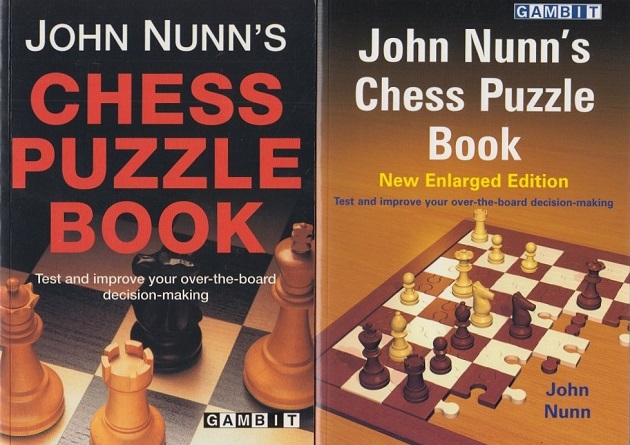
8977. A familiar old position
From page 41 of The Middle Game in Chess by E. Znosko-Borovsky (London, 1938):
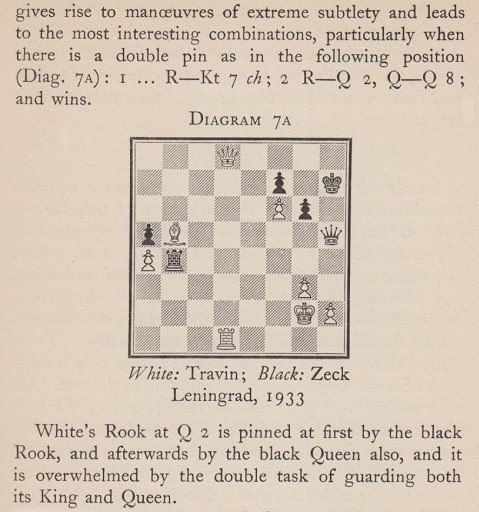
The same diagram and information were on page 47 of The Basis of Combination in Chess by J. du Mont (London, 1938). Do readers know of earlier appearances of this game, including details about the players, occasion and full score?
The present item examines how the position has been handled by the uncaring. For example, on page 13 of The Times Winning Moves (London, 1991) Raymond Keene omitted the white bishop on b5 and had Travin as Black:
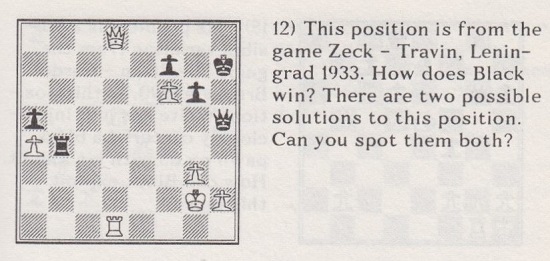
Travin was also given as Black on pages 280-281 of Encyclopedia of Chess Wisdom by Eric Schiller (New York, 1999):
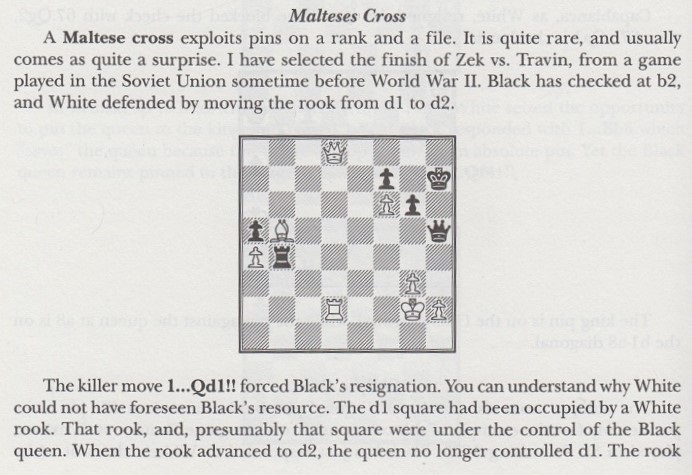

The phrase ‘from a game played in the Soviet Union sometime before World War II’ is not a hallmark of scholarship. The faulty diagram (with the rook on b4 instead of b2) and the ‘Malteses [sic] Cross’ heading were mentioned in A Sorry Case. Note too how a move by Black ‘forced Black’s resignation’.
Another sighting of Travin as Black is on page 20 of Chess Techniques by A.R.B. Thomas (London, 1975), but there was a particular reason:
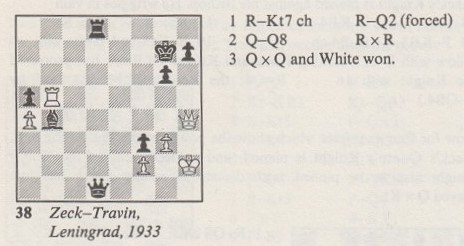
Thomas set out his strange practice in the Introduction (page ix):
‘One feature of the book needs explanation. The diagrams are given from White’s point of view and White is remarkably successful. This is due to the fact that the colours have been reversed, together with the players’ names, whenever Black has won. In all such cases the number of the diagram is in bold type.’
So far, nothing has been found which disproves the basic historical information about the game from Znosko-Borovsky and du Mont in 1938. For reasons unknown, on page 15 of Chess Life, October 2009 A. Soltis stated that the position had arisen between Lev Travin and Ilya Zek in Leningrad in 1938 [sic].
He then put forward an analytical correction: after 1...Qd1 2 Rxb2 Qxd8 3 Rf2 ‘Black can’t win’.
A more diligent writer than A. Soltis would have avoided giving any impression that the drawing line was his own discovery. For instance, Black’s inability to win after 3 Rf2 had been mentioned by Jude Acers on page 60 of the May 1983 Chess Life, in the ‘Larry Evans on Chess’ column (an item which began with an incorrect title for Znosko-Borovsky’s book):
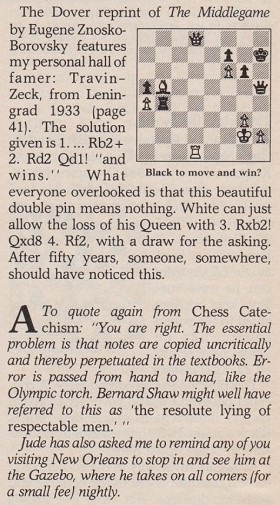
A more diligent writer than L. Evans (whose reference to uncritical copying suggests a stark lack of self-awareness) would have mentioned that the information from Acers was nothing new. Thirty years previously Evans himself had been corrected on the identical point, i.e. for overlooking the draw on pages 37 and 40 of a book which he co-authored with Tom Wiswell, Championship Chess and Checkers for All (New York, 1953). The correction was made by Norman T. Whitaker on page 192 of CHESS, July 1953:
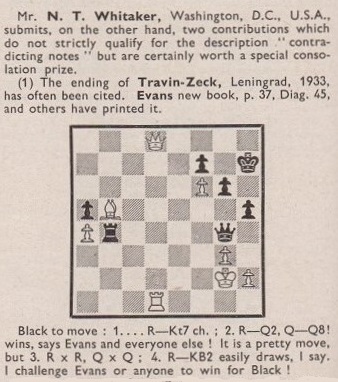
Loath to provide sources or admit uncertainty, copy-and-bungle writers baldly present their version of the ‘facts’ as ironclad, never informing the reader that something else can be found somewhere else. Since 1953, it seems, only confusion has been added to the ‘Travin v Zeck’ matter.
8978. B.H. Wood
Olimpiu G. Urcan (Singapore) has forwarded a number of photographs from the Illustrated London News, and they will be shown here in occasional batches. Below are three portraits of the magazine’s long-standing chess columnist, B.H. Wood (1909-89):
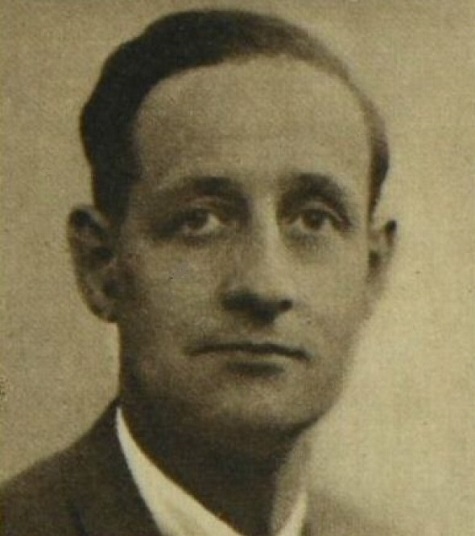
Illustrated London News, 26 December 1953, page 1081
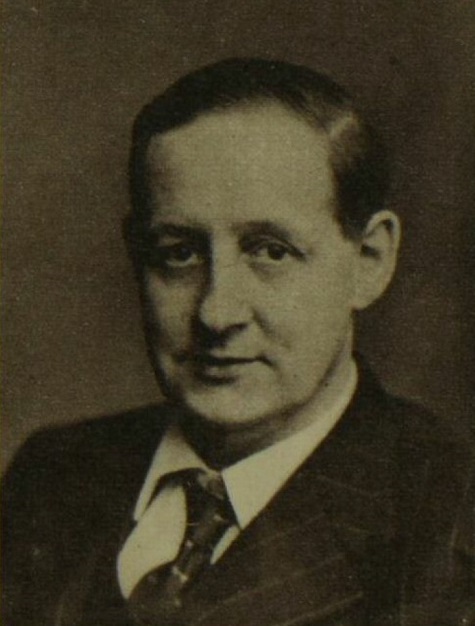
Illustrated London News, 25 December 1954, page 1175
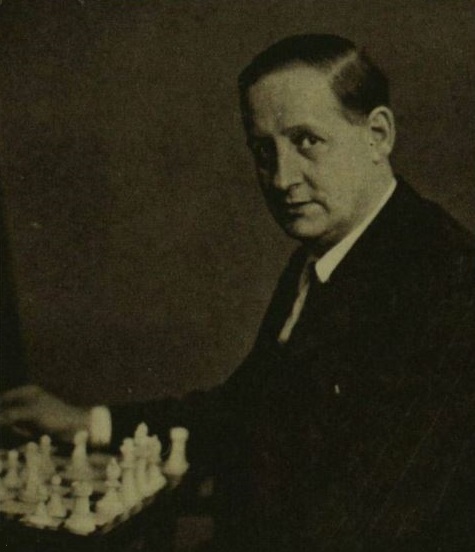
Illustrated London News, 10 December 1955, page 1028.
The beginning of an advertisement on a cover page of B.H. Wood’s magazine, CHESS, November 1974:

8979. Chess in the London Evening Standard
In C.N. 6712 (see too Chess Records) Leonard Barden notified us that his daily (Monday-Friday) chess column in the London Evening Standard began in early June 1956 and that (apart from one week in May 2009 when it appeared on-line only) it continued in the newspaper until 30 July 2010. Since then, it has been published exclusively on-line. That C.N. item asked whether there had ever been, in any journalistic field, such a run for a daily column by a single individual; no competing claims were received.
Now, however, we learn that although Leonard Barden had hoped to continue until at least June 2016, completing a 60-year run, the newspaper intends to terminate the column at the end of December 2014.
8980. Lasker and
photographs
What is the basis for a statement about Emanuel Lasker on page 57 of Chess is Chess by Aleksandar Matanović (Belgrade, 1990)?
‘Poor Lasker prepared for his tournaments by studying the photographs of his future opponents. Having nothing else at hand, he scrutinized their facial features and tried to penetrate into their psyches.’
8981. Chernev’s forename
Gerard Killoran (Ilkley, England) notes that a century ago reports in the Brooklyn Daily Eagle referred to Isidore, not Irving, Chernev. One of several instances is on page 38 of the 15 October 1916 edition:

We see that page 3 of the Brooklyn Daily Eagle, 12 March 1913 had ‘Isidor Chernev’.
8982.
Caricatures in The Graphic (London, 1922)
Mr Killoran also provides a set of caricatures on page 261 of The Graphic, 19 August 1922:

8983. Capablanca v S. Bernstein, Brooklyn, 1928
A third contribution from our correspondent concerns Capablanca’s draw against Sidney Bernstein in a simultaneous exhibition and shows that when writing to us about the game in 1987 (see A Great Chess Figure) Bernstein forgot not only certain details but also the fact that he had annotated the game on page 6A of the Brooklyn Daily Eagle, 27 December 1928. Mr Killoran provides the cutting:

1 d4 Nf6 2 c4 e5 3 dxe5 Ng4 4 e4 h5 5 Be2 Nxe5 6 f4 Ng4 7 g3 Bb4+ 8 Nc3 Qe7 9 Qc2 Nc6 10 Nf3 h4 11 gxh4 Rxh4 12 Bd2 Rh3 13 O-O-O Bxc3 14 Qxc3 Nf2 15 Qxg7 Nxh1 16 Rxh1 Qf8 17 Qg2 Rh8 18 Rg1 d6 19 Bc3 f6 20 Qg6+ Qf7 21 Bxf6 Qxg6 22 Rxg6 Kf7 23 f5 Rg8 24 Ng5+ Kf8 25 h4 Ne5 26 Bxe5 Rxg6 27 fxg6 dxe5 28 h5 Kg7 29 Nf7 Kf6 30 Nh6 Be6 31 Bg4 Bxg4 32 Nxg4+ Kg7 33 Nxe5 Rh8 34 Kc2 Rxh5 35 Nd3 Rh2+ 36 Kc3 Kxg6 37 a4 Drawn.
White’s 34th move was recorded as 34 Kc2, and not 34 Kd2 (as given by Rogelio Caparrós’s books on Capablanca and, subsequently, in databases).
8984. Ströbeck (C.N. 8975)
Michael Clapham (Ipswich, England) owns this photograph:
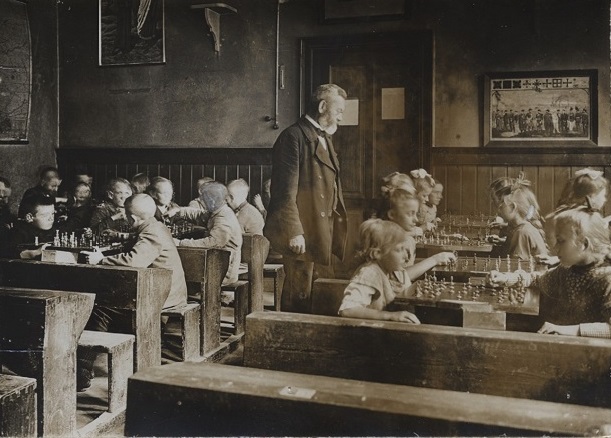
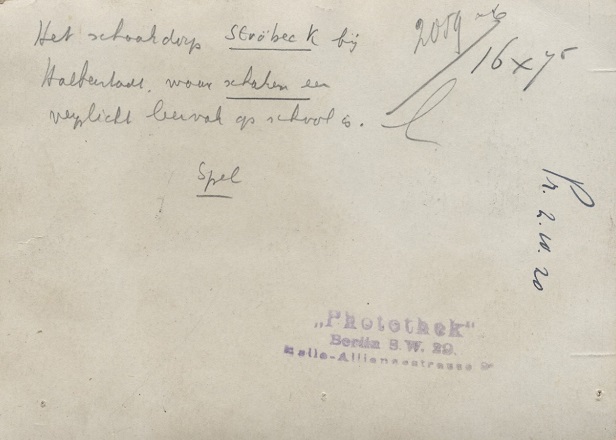
8985. Rook and pawn ending (C.N. 8858)
C.N. 8858 gave this extract from page 67 of Ludwig Bachmann’s Schachmentor (Ansbach, 1904):
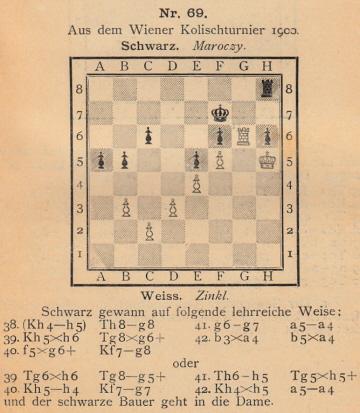
The missed mate in one (39 Kxh6 Rh8) can also be found on page 61 of another work by Bachmann which has the identical text:
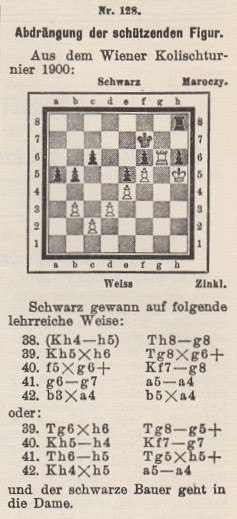
We have that book under two titles, Schach durch Selbstbelehrung u. Selbstunterricht (Berlin, 1929) and Schach Praktisches Lehrbuch (Berlin, undated). The respective title pages specified ‘23. Auflage’ and ‘25. Auflage’.
8986. Chess Tactics

Future C.N. items will examine some positions in Chess Tactics by Alexander Kotov (London, 1983). First, though, attention is drawn to the concluding ‘Translator’s Note’ (pages 142-143), a tribute by John Littlewood to Kotov, who had died in 1981. We wonder what lay behind the crusty second paragraph:
‘It has always struck me as sad that the younger generation of British players did not see Kotov visit this country until he was over 30 years past his prime, brought in as an ageing grandmaster to bestow dubious prestige on some ostensibly budding World Champion who managed to beat him during a simultaneous exhibition ...’
8987. Bohemia
From pages 361-362 of Mannheim 1914 and the Interned Russians by A.J. Gillam (Nottingham, 2014):
‘Capablanca in his article Chess in the Last Three Years published in Bohemia, a German language Prague newspaper on 20 January 1918, commented that ...’
It is not mentioned how the author researched such a German-language Prague newspaper, and it would be fascinating to see a copy.
Pages 89-92 of our book on Capablanca gave, under the title ‘Chess in the Last Three Years’, an article by him which we found on page 13 of the 20 January 1918 issue of the Spanish-language Cuban magazine Bohemia.
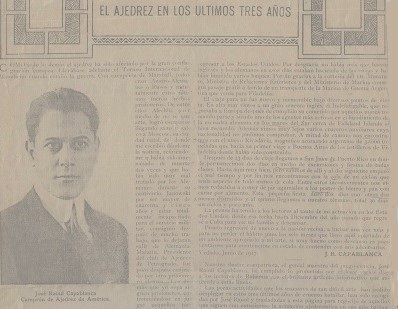
8988. Fine v Horowitz match
From Eduardo Bauzá Mercére (New York, NY, USA):
‘Pages 50-52 of Aidan Woodger’s Reuben Fine A Comprehensive Record of an American Chess Career, 1929-1951 (Jefferson, 2004) have an account, with nine game-scores, of the match played in 1934 between Fine and Al Horowitz. It is stated that the final score was 6-3 in favor of Fine.
In fact, there was a tenth game, a draw, published on page 14 of the Brooklyn Daily Eagle, 5 July 1934.’
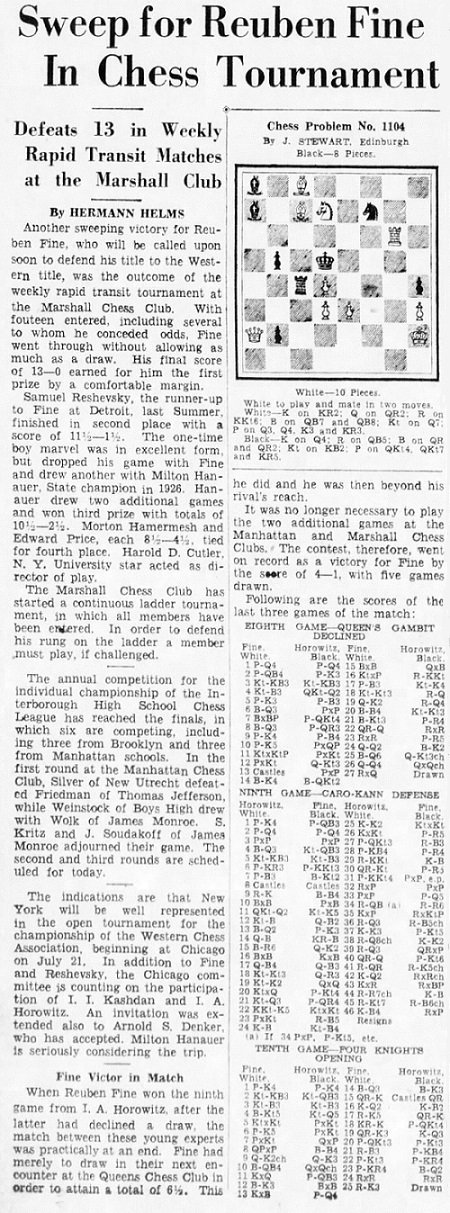
1 e4 e5 2 Nf3 Nc6 3 Nc3 Nf6 4 Bb5 Nd4 5 Nxd4 exd4 6 e5 dxc3 7 exf6 Qxf6 8 dxc3 Bc5 9 Qe2+ Qe6 10 Bc4 Qxe2+ 11 Kxe2 c6 12 Be3 Bxe3 13 Kxe3 d5 14 Bd3 Be6 15 Rae1 O-O-O 16 Kd2 Kc7 17 Re5 Rde8 18 Rhe1 b5 19 R5e3 Kd6 20 b3 g6 21 Rf3 f5 22 g3 h5 23 h4 Bd7 24 Rxe8 Rxe8 25 Re3 Drawn.
Page 129 of the August 1934 Chess Review confirmed:
‘Reuben Fine defeated I.A. Horowitz in their match by the score of 4-1 and five draws.’
8989. Chernev’s forename (C.N. 8981)
Roger Mylward (Lower Heswall, England) writes:
‘I have examined the United States Federal Census for 1910 and 1920 covering the Brooklyn area of New York. In 1910 the following family members were living in Brooklyn Ward 16, Kings, New York: William Chernev (aged 34), Mollie Chernev (33), Isidor Chernev (10), Celia Chernev (8) and Rose Chernev (4). The family had emigrated from Russia in 1907; William was a retail merchant dealing in groceries.
In the 1920 Census, the family (living in Brooklyn Assembly District 6) consisted of William Chernev (aged 45), Irving Chernev (19), Celia Chernev (18), Rose Chernev (14) and Michael Chernev (8).
The 1915 New York State census had the forename Isidor. According to the New York Death Index, Mollie Chernev died, aged 42, on 18 October 1919 in King’s, New York.’
8990. Kotov (C.N. 8986)
From Leonard Barden (London):
‘At the time John Littlewood wrote his comment about Kotov I wondered what he had in mind. I organized two clock simultaneous exhibitions for Kotov in London against selected juniors. One, on about ten boards, was during the Lord John Cup in September 1977. All the competing grandmasters (the others were Hort, Quinteros and Torre) gave clock displays on the free day. Hort crushed the strongest group, which included the future grandmasters Daniel King and William Watson. Kotov had the weakest group and scored well, though losing one or two. The other occasion was in early November 1978, when Kotov gave a 12-board exhibition against selected under-13 juniors. His score (6 –3 =3) was good, given the tough opposition. Neil Carr won a widely published game.
Kotov had a heart condition and told me that he was glad to have the simultaneous assignments because he could use the money to buy medication, for himself and his wife, which was not available in the Soviet Union. He did not appear to have any physical problems during either event.
I remember thinking in the 1980s that John Littlewood’s comment would have had more weight if made in connection with the three-game match at Borehamwood in November 1979 which Kotov lost to Ian Wells (one win and two defeats). Wells was then aged 15. Kotov made several errors in those games and was suffering physically after around three hours’ play.’
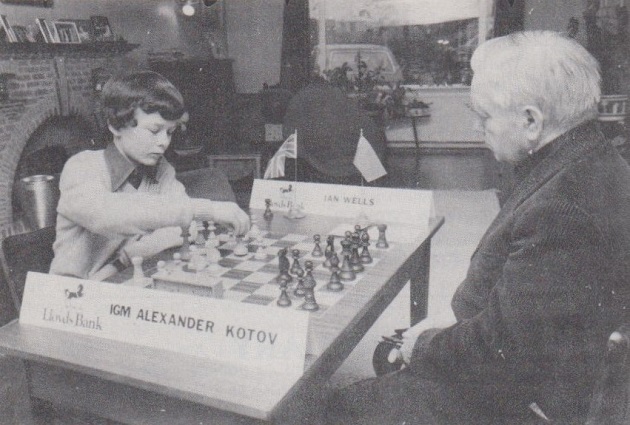
BCM, March 1982, page 102
The report on pages 1-2 of the November 1979 CHESS stated that before the match with Kotov, Wells had never played against a grandmaster. Their post-match comments were quoted:
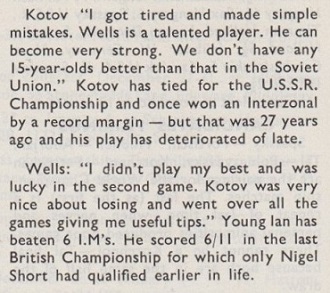
With regard to that match, Mr Barden informs us:
‘It was held at the home of Malcolm Fox, who was then the organizer of the annual Borehamwood congress. He was a nephew of the many times Canadian champion Maurice Fox. Malcolm Fox made the arrangements and provided hospitality for both players. His son Neil was a talented junior and played some blitz games with Kotov during the match. Kotov was persuaded to play the match when I told him that Wells was from the same part of the country, and of similar promise for his age, as Gordon Crown was in 1947.’
Certain databases suggest that in 1979 there was also a match, in Brighton, between Lodewijk Prins and Ian Wells, but the Dutchman’s opponent was Peter Wells. For example, the following appeared in a report by J. Speelman on pages 95-96 of the March 1980 BCM:
‘... a match between IM Ludovic [sic] Prins (NL) and Peter Wells, the British U-16 champion.’
8991. P.H. Clarke (1933-2014)
1. How could the BCM put on-line such a poorly written ‘obituary’ of P.H. Clarke?
For example:
‘At the British Championships itself he finished second on his first appearance; he was to tie for silver medal on no less than five occasions, appearing, almost without a break for thirty years, a run that ended in 1982.’)
2. How could the English Chess Federation even consider reproducing such a text on its own website?
8992. ‘One of the finest combinations ever played’ (C.N. 8976)
Dan Scoones (Coquitlam, BC, Canada) points out an article by Mark Dvoretsky at the e3e5.com website which expresses ‘serious doubts’ about the authenticity of the game, praises John Nunn’s work and mentions that there was a study composer named Alexander Pavlovich Dolukhanov.
8993. A familiar old position (C.N. 8977)
Mr Scoones also draws attention to the crosstable for a national tournament in Leningrad in 1933 which recorded a victory by Travin over Zek.
8994. Kmoch on Tartakower
Page 263 of Chess Explorations quoted a statement by Hans Kmoch that at Dubrovnik, 1950 Tartakower ‘had lost his zest, hinted occasionally at suicide’. Below is the complete passage from Kmoch’s article on pages 123-125 of the April 1956 Chess Review:
‘After the War, I met Tartakower at the Groningen tournament, Holland, 1946. He was the same. But, four years later, at Dubrovnik, Yugoslavia, he had entirely changed. Gone was his good figure as he had grown an enormous hypochrondium. Gone was much of his vivacity, gone, too, the facility and stirring anapest of his talk. Needless to say, his chess had deteriorated correspondingly. He had lost his zest, hinted occasionally at suicide. Only now and then did his grim sense of humor break through; for instance, on that hot day he had ordered iced water, got lemonade, instead – and washed his face with it.
They treated him very generously in Yugoslavia. But, when I met him shortly after in Paris, he again was penniless. Why? Well, just a petit jeu, you know. His case was hopeless.
Maybe, he should have married; but he used to claim to be too ugly for that, and too poor. According to one report, though, he did marry, shortly before his death.’
As ever, solid information is sought. ‘According to one report ...’ will never do.
Below is a page, inscribed by Tartakower, from our copy of Book of the Warsaw 1935 International Chess Team Tournament by Fred Reinfeld and Harold M. Phillips (New York, 1936):

8995. Coming next ...
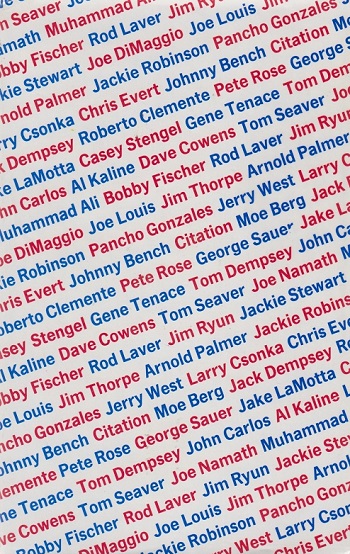
8996. The greatest sports event in history
The final paragraph of the Introduction on page 16 of Fischer vs. Spassky by S. Gligorić (New York, 1972):
‘The challenger was, perhaps, right when he claimed: “It will probably be the greatest sports event in history. Bigger even than the Frazier-Ali fight ...”’
It has been affirmed (see, for instance, page 18 of the November 1999 Chess Life) that Fischer made that remark ‘on the eve’ of the Reykjavik match, but we have traced it back to a syndicated newspaper article by Ira Berkow published in January 1972. One of many outlets available on-line is the Lompoc Record, 17 January 1972, page 7.
The interview by Berkow (‘New York, January 1972’) was included on pages 79-82 of his anthology Beyond the Dream (New York, 1975), under the title ‘Bobby Fischer: Sportin’ Champ’. From page 79:


8997. Staunton and the world championship title
A passage about FIDE’s regulation of world championship matches, on page 35 of Fischer/Spassky by Richard Roberts with Harold C. Schonberg, Al Horowitz and Samuel Reshevsky (New York, 1972):
‘About one thing there is no question: The present system is far superior to the one that permitted Howard Staunton to call himself the champion of the world although he refused to play Paul Morphy, the New Orleans-born genius who had swept through America and Europe decimating the finest players the world had to offer.’
Concerning Staunton, the opportunity is taken to request additions to Early Uses of ‘World Chess Champion’.
8998. Another certainty
The final paragraph of the 1972 world championship match book mentioned in the previous item declared (page 198):
‘One thing is certain: Three years from now there will be a new match for the chess championship of the world.’
8999. Chessy words
On the topic of chessy words Rod Edwards (Victoria, BC, Canada) quotes from page 360 of the Chess Monthly, November 1859:
‘From W.H.W. of St Louis we have a suggestion in response to the allusion made in a late number in reference to the want of an adjective in the English language which should signify of or belonging to chess. He proposes chessic or chessical with the adverb chessically. These words have we believe been previously used, but all attempts to introduce them permanently have failed. The sole objection to these terminations seems to be that they are classic and are properly affixed only to words of Greek or Latin origin, or used to represent the French ending ique. Another correspondent stoutly maintains the availability of scacchic – others mention chessical, chessian, zatrikial and exchequerian.’
9000. Alekhine in Trinidad
From page 8 of Chess Tactics by Alexander Kotov (London, 1983):

Why the name Johner?
The position, well known, is on page 635 of the Skinner/Verhoeven book on Alekhine as a victory by the world champion against A. Nestor in a simultaneous display in Port of Spain, Trinidad on either 31 January or 4 February 1939. The only full game available from Alekhine’s visit to Trinidad is a draw against Raymond Young (who had written on page 11 of the August 1993 Chess Life that Alekhine’s two displays were ‘on successive nights’ and that he believed they took place ‘in late 1939 or early 1940’).
As noted by Skinner and Verhoeven, the Alekhine v Nestor conclusion appeared in the Deutsche Schachzeitung in 1939 (in a feature on pages 197-198 of the July issue):

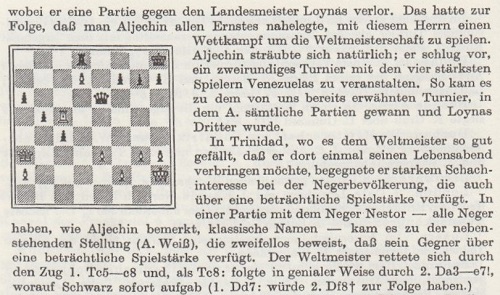
The position and solution were given again on pages 310 and 318 of the December 1939 issue, the finish being described as ‘wunderhübsch’.
Another early publication of the ending was in Brian Harley’s column on page 20 of the Observer, 30 July 1939:
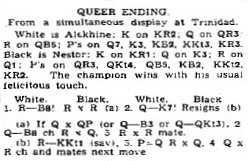
On page 71 of Achieving the Aim (Oxford, 1981) Botvinnik referred to his title match discussions with Alekhine immediately after AVRO, 1938:
‘We agreed that I should send a formal challenge to an address he gave in South America (Alekhine was intending to buy some land in Trinidad) ...’
9001. Hartston quote
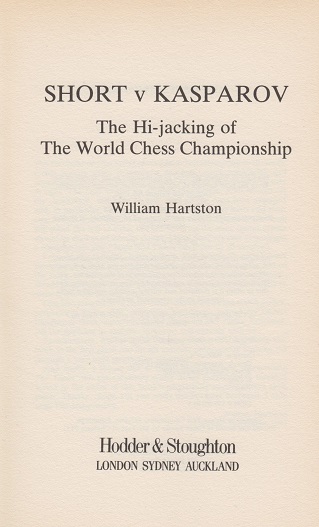
From page 1 of Short v Kasparov The Hi-jacking of The World Chess Championship by William Hartston (London, 1993):
‘The game of chess, with its complexities just beyond the mastery of either man or machine, has always been a refuge for an entertaining mixture of eccentrics, obsessives, dogmatists, pragmatists and even the occasional genius. As competitive as any sport, yet as intellectually demanding as any academic pursuit, it demands of its leading practitioners a dedication approaching monomania.’
As regards the title of the book, in case of divergence our practice is to follow the title page and not the front cover.
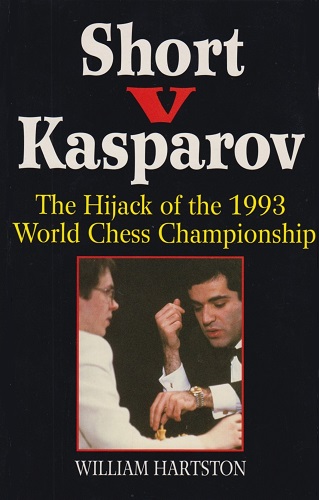
9002. A nineteenth-century grammar lesson
A grammar lesson on how to label 1 e4 e5 2 Nf3 Nc6 3 Bc4 Bc5 4 b4 was dispensed on page 5 of the Chess Player’s Magazine, January 1867 (in the article ‘Our Penmen and Pressmen’ by ‘N.R.W.’ which was mentioned in C.N. 8952):
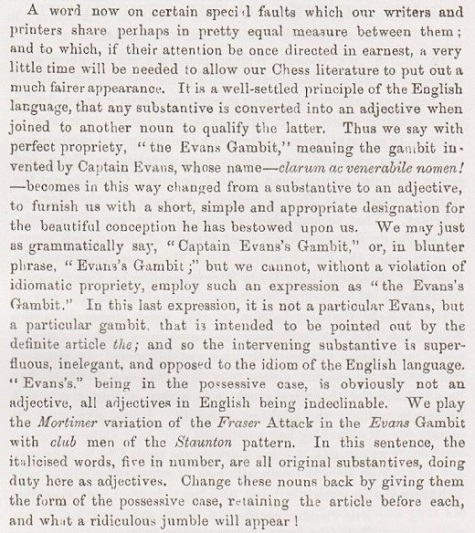
9003. Sources

From undiscerning websites based on gossiping, bickering and kibitzing one can count on nothing better, but there are even ‘historians’ who do not bother with sources. For example, Wilhelm Steinitz First World Chess Champion by I. and V. Linder (Milford, 2014) has, on pages 188-190, a section headed ‘World Champions about Steinitz’, comprising a sequence of quotes from Lasker to Kramnik. Many, though not all, mention a year, but not a single one has a source. Capablanca’s comments on Steinitz, for example:

For the information which the book would not give, see Capablanca on his Predecessors.
9004. Front-page headline
Further to Chess as Front-Page News, below is page 1 of the Los Angeles Times, 1 September 1972:
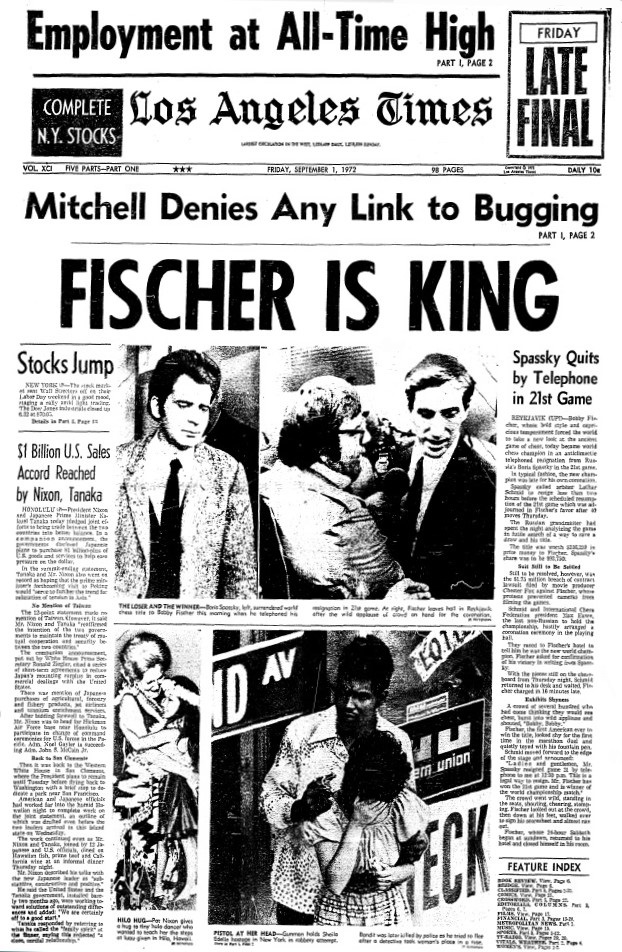
9005. Alekhine in Trinidad (C.N. 9000)
Christian Sánchez (Rosario, Argentina) writes:
‘The Trinidad Guardian of 14 May 2008 gives a detailed account of Alekhine’s visit to the island, but only his opponent’s middle initial can be added: A.L. Nestor.’
9006. Hanham v Ryan
With regard to Indian Openings in Chess, Robert John McCrary (Columbia, SC, USA) points out the first note to the game between Hanham and Ryan published on pages 209-210 of the July 1886 International Chess Magazine:
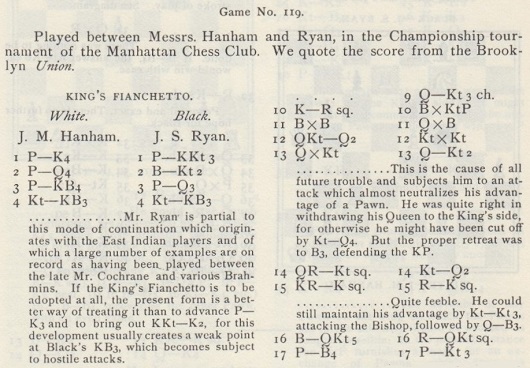
Concerning the conclusion of the game, see page 291 of A Chess Omnibus.
9007. Firefighting (C.N.s 8927 & 8943)
Tomasz Lissowski (Warsaw) forwards, courtesy of Paweł Dudziński, the cartoon by Zbigniew Lengren as it appeared on page 98 of Z szachami przez wieki i kraje by Jerzy Giżycki (Warsaw, 1960):
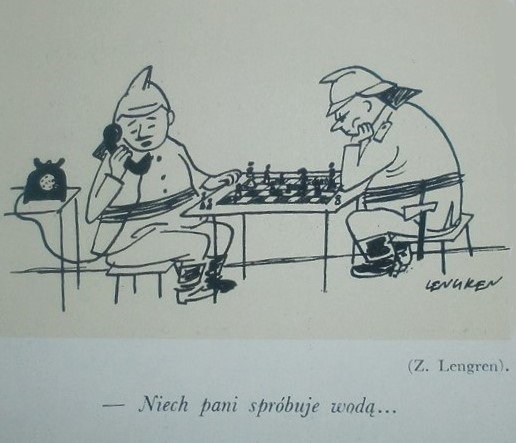
Lisa Lane’s very similar cartoon was on the front cover of Chess Life, 20 April 1961.
9008. Contradictory versions
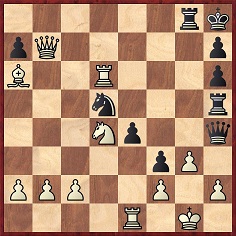
White to move.
In this position on page 141 of Chess Tactics by A. Kotov (London, 1983) the caption was ‘Oneskins-Gama, Switzerland, 1956’. The moves given were 1 Nxf3 exf3 2 Qg7+ Rxg7 3 Re8+ Rg8 4 Rxg8+ Kxg8 5 gxh4, but it was not stated exactly how the game ended.
The same diagram was on page 290 of Combination in Chess by G. Négyesy and J. Hegyi (Budapest, 1965), labelled ‘Onescius-Gama, Switzerland, 1956’. It was said that after 1 Nxf3 exf3 2 Qg7+ Kxg7 3 gxh4 ‘White achieved a draw’. On page 43 of How To Think in Chess by J. Przewoznik and M. Soszynski (Milford, 2001) there was also a black pawn on f6, and page 65 stated that although White could have won with 1 Qg7+ he resigned. The position was identified as ‘Onescius-Gama, Bucharest, 1955’.
9009. Puzzles by Sam Loyd
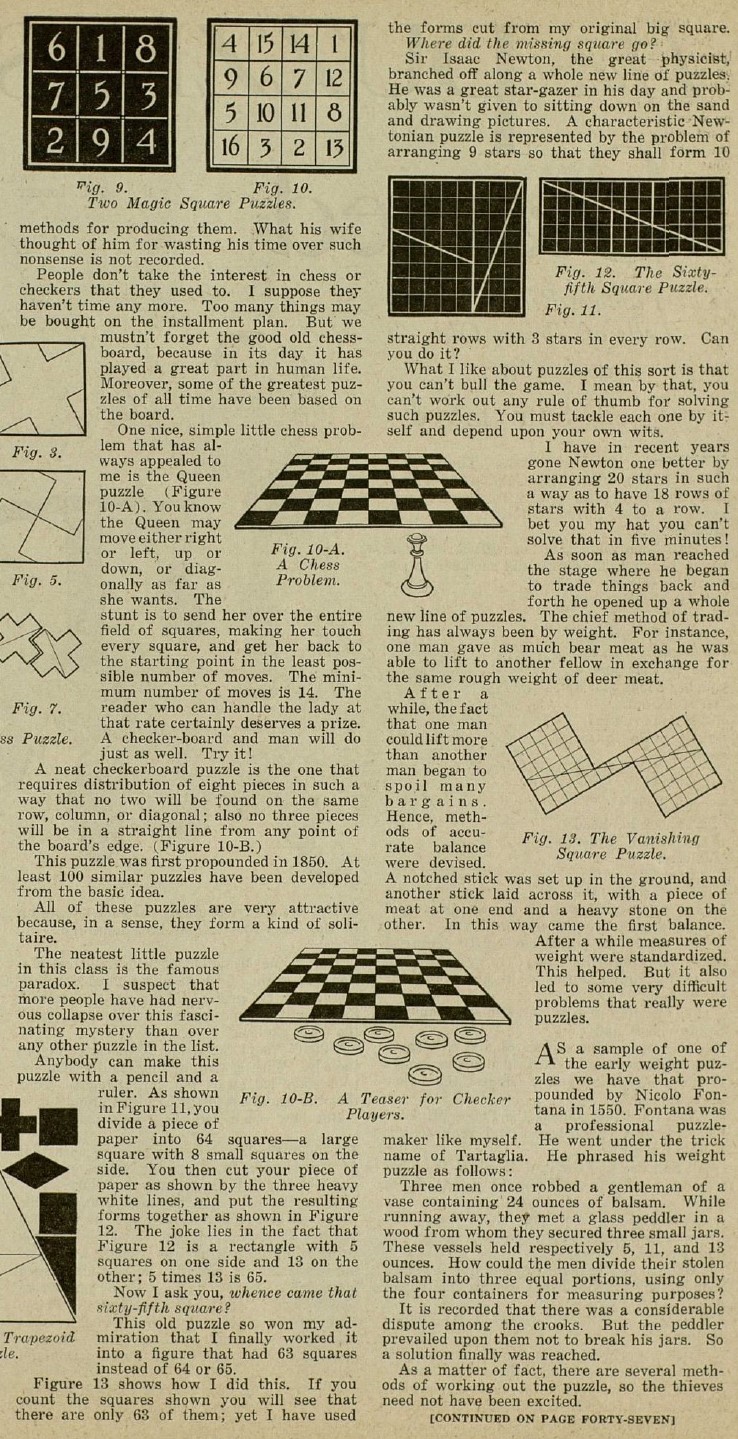
This is an extract from ‘How Puzzles Started’ by Sam Loyd, an article published on pages 41, 42 and 47 of Liberty, 12 March 1927.
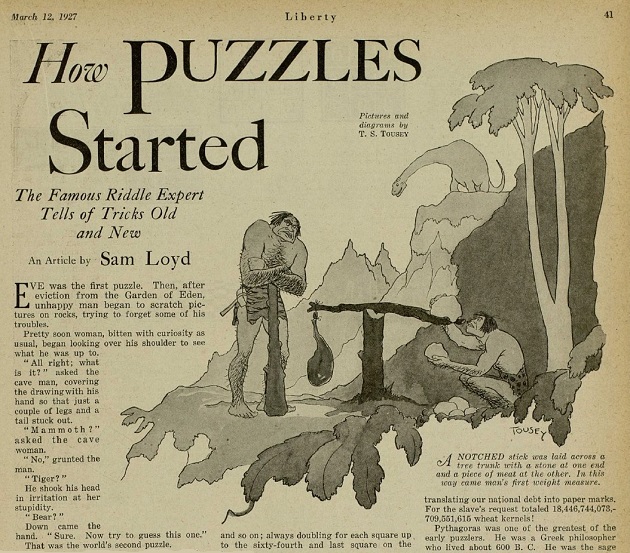
The solutions will be shown in a future C.N. item. Loyd, it should be recalled, died in 1911.
9010. Fischer
quote (C.N. 5534)
C.N. 5534 asked for the earliest known appearance of the famous quote attributed to Bobby Fischer, ‘All I want to do, ever, is play chess’.
From page 98 of Life, 21 February 1964, in the article ‘One-Track Mastermind’ by Jane Howard which was referred to in C.N. 5200:
‘Bobby hasn’t the slightest flicker of doubt who he is or what he wants to do. In an age that idolizes well-roundedness he has a single aim: “All I want to do, ever”, he says, “is play chess”.’
From page 100:
‘“Women are lousy at chess”, says Bobby. “They’re meant to stay home. I bet I could take any man of average intelligence, a rank beginner, give him oh, around two months of lessons, and have him at the end of that time beat the women’s world champion.’
Concerning his daily routine in Brooklyn, Fischer was quoted as follows on the same page:
‘... I pick up the Times, see if it’s got anything on chess, then read the News. But mostly I read chess magazines. I get around ten a month. You have to keep up. I’ve learned enough Russian and some of those languages to make out their chess magazines. Chess is much more popular other places than here. The Latvian chess magazine has a circulation of 30,000 a month; ours is only 9,000.’
The final two paragraphs of the article (also on page 100):
‘Always in his mind are the 64 squares of a chessboard, with its pieces arranged in one of millions of possible combinations. Always he is thinking of his next match.
“It’s not exactly easy, keeping up the championship”, he says. “It’ll keep me busy all the rest of my life.”’
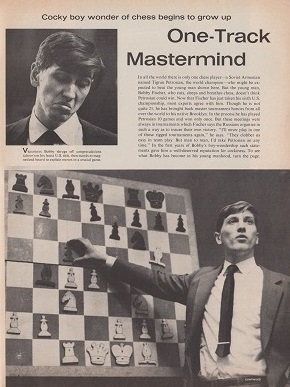
Page 97 of Life, 21 February 1964
The article was mentioned on page 72 of Chess Review, March 1964:
‘Life magazine gives Robert J. Fischer a fairly good story in its 21 February issue. We can’t subscribe to all it says nor all it quotes Fischer on. It is “fairly good”, however, in that it doesn’t try to present his worst side nor make chess too queer for “regular people”. Yet there is some adverse slanting, and the photos tend to catch Fischer at beatnik angles.
When can we expect a good article from outside publications?’
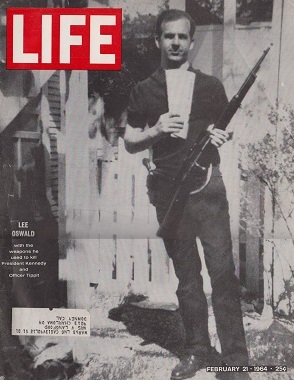
9011. Announcements
From Marek Soszynski (Birmingham, England):
‘When my Polish father taught me to play chess in the 1960s he would call szach! (Polish) when delivering a check, and gardez! (French) when attacking a queen. However, he would also call tour! (French) when attacking a rook, and I wonder how common that practice was.’
9012. Contradictory versions (C.N. 9008)
Christian Sánchez (Rosario, Argentina) has found the conclusion of the game on the back cover of the 7/1956 issue of Revista Română de Șah (Onesciuc v Gama, Sighet championship, 1955):
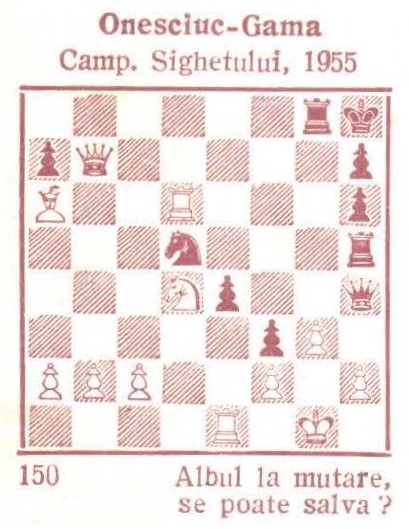
It was stated that White played 1 Qxh7+ and lost, whereas the line beginning 1 Nxf3 exf3 2 Qg7+ (‘a genuine problem-like move’) would have saved the game:
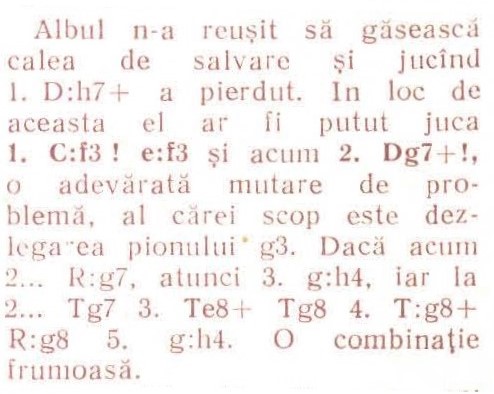
Our correspondent also points out that the inside front cover of the 6/1955 issue of the Romanian magazine mentioned D. Onesciuc from Sighet and A. Gama from Baia Mare when listing the prize-winners in a problem-solving competition organized by the magazine:

Page 28 of the 2/1956 issue reported that the Sighet championship, in which 40 players took part, was won by A.D. Gama:
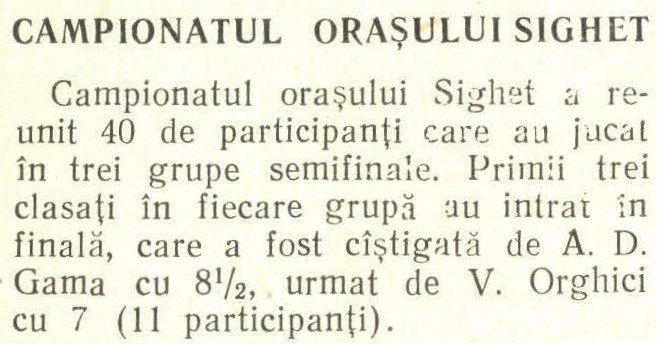
9013. Chess is Chess (C.N. 8980)
In Chess is Chess by Aleksandar Matanović (Belgrade, 1990) the main source often seems to be thin air. A variant of the ‘Looking one move ahead’ claims listed in the Factfinder is on page 16:
‘When Reshevsky was asked how he managed to triumph over his opponents, he said: “Nothing to it. I just see one move ahead of my opponent.”’
9014. Colle v Capablanca
The concluding paragraph of Harry Golombek’s notes to Colle v Capablanca, Carlsbad, 1929 on page 187 of Capablanca’s Hundred Best Games of Chess (London, 1947):
‘This game is Capablanca at his best, full of subtle touches for the full exploitation of positional weaknesses. After the game Colle is reported to have said: “It seems to me I did not make a weak move, but that my opponent played some very strong ones.” This feeling was very familiar to most of Capablanca’s opponents.’
Golombek gave no source for the remark by Colle, but the following was Victor Soultanbéieff’s final note in his comments on the game in L’Echiquier, November 1929, pages 502-503:
‘Partie très instructive et typique du style de Capablanca qui profita avec habileté et précision de quelques faiblesses presqu’imperceptibles dans la position de son adversaire qu’il créa par des manœuvres raffinées.
Ce qui surprend dans la présente partie c’est que les Bl. perdirent sans commettre de fautes visibles. “Il me semble que je n’ai pas fait de coup faible, dit Colle après la partie, mais mon adversaire joua des coups très forts.” Combien de victimes de Capablanca pourraient en dire autant!’
9015. Puzzles by Sam Loyd (C.N. 9009)
The answers published in Liberty, 19 March 1927, pages 63-65:
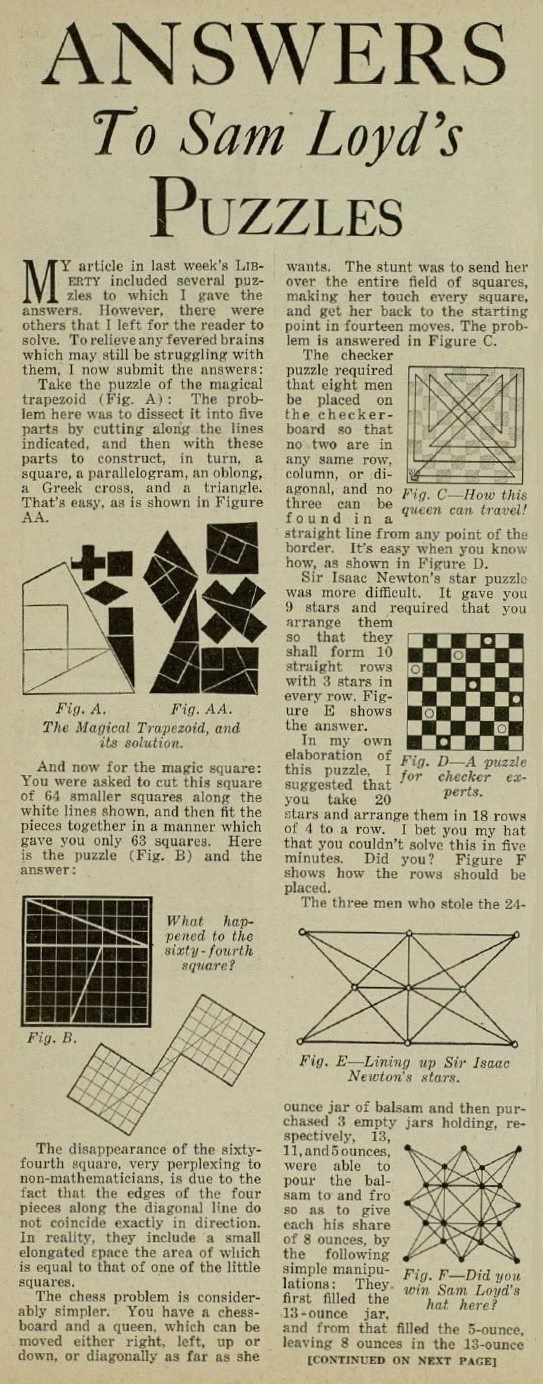


9016. Gambit Chess Rooms (C.N. 8975)
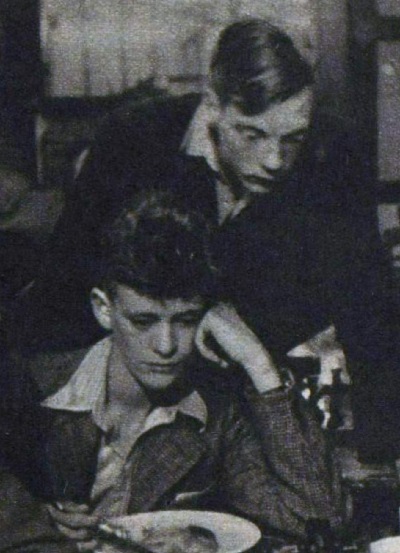
Picture Post, 12 January 1946, page 23
Leonard Barden (London) writes:
‘The young man standing is John Fuller, the 1949-50 Hastings Premier and British championship player who at the time of the photograph had just shared first place with me in the London under-18s championship.
The spectator seated below him is, I believe, a young Jim Slater, the saviour of Reykjavik 1972, who was at that time a keen player and a good friend of Fuller’s at their school in Harrow.’
9017. Barden bibliography
We have prepared a list of books written by Leonard Barden:
- A Guide to Chess Openings (London, 1957)
- How Good is Your Chess? (London, 1957 and New York, 1976)
- Chess (London, 1959). Also issued as An Introduction to Chess Moves and Tactics Simply Explained (New York, 1964)
- Modern Chess Miniatures (London, 1960 and New York, 1977). Co-authored with W. Heidenfeld
- The Ruy Lopez (Oxford, 1963, New York, 1964, plus re-issues)
- 30th USSR Chess Championship, 1962 (Nottingham, 1963)
- The Guardian Chess Book (London, 1967)
- An Introduction to Chess (London, 1968 and New York, 1972)
- The King’s Indian Defence (London, 1969, London, 1973 and Dallas, 1973). Co-authored with W. Hartston and R. Keene
- How To Play the Endgame in Chess (London and Glasgow, 1975)
- The Batsford Guide to Chess Openings (London, 1976). Co-authored with T. Harding. Also issued as Guide to the Chess Openings (New York, 1977)
- Leonard Barden’s Chess Puzzle Book (London, 1977)
- Chess. Master the moves (London, 1977)
- The Master Game (London, 1979). Co-authored with J. James
- Play Better Chess (London, 1980 and London, 1987)
- Openings for the Club Player (London, 1987). Co-authored with T. Harding. Also issued as Chess Openings for the Average Player (New York, 1998)
- The Batsford Chess Puzzle Book (London, 2002)
- One Move and You’re Dead (London, 2007). Co-authored with E. Brecher. Also issued as Chess. 80 Classic Problems (London, 2009).
The list does not include translations of these books, or books by other authors which he translated or revised or to which he made a contribution. Examples of those four categories are, respectively:
- 300 rompecabezas de ajedrez (Madrid, 2005)
- Chess with the Masters by M. Beheim (London, 1963)
- The Elements of Chess by J. du Mont (London, 1956)
- Bobby Fischer’s Chess Games by R.G. Wade and K.J. O’Connell (London, 1972 and New York, 1972).
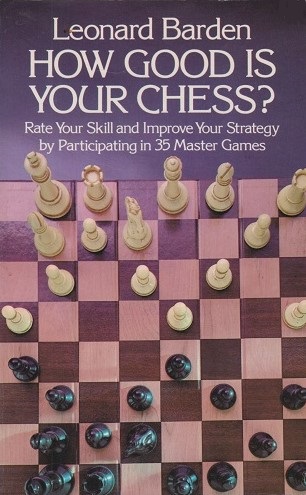
9018. Tartakower v Rey Ardid, Paris, 1934
From page 52 of My Best Games of Chess 1931-1954 by S.G. Tartakower (London, 1956):

The full score of this exhibition game between Tartakower and Ramón Rey Ardid (Paris, September 1934): 1 d4 d5 2 c4 e6 3 Nc3 Nf6 4 Bg5 Be7 5 e3 h6 6 Bf4 Bd6 7 Bg3 b6 8 cxd5 exd5 9 Bd3 O-O 10 Nf3 Bb7 11 Rc1 Ne4 12 Bxe4 dxe4 13 Nd2 Qe7 14 Qb3 Bxg3 15 hxg3 Na6 16 O-O c5 17 Qa3 f5 18 dxc5 Rfd8 19 Nb3 Rac8 20 cxb6 Qxa3 21 bxa3 axb6 22 Nd4 Nc5 23 Nxf5 Ra8 24 a4 Ba6 25 Rfd1 Bd3 26 Rd2 Rd7 27 Rb2 Nxa4 28 Nxa4 Rxa4 29 Rc8+ Kh7 30 Rxb6 Rxa2 31 Nh4 Ra1+ 32 Kh2 Rb1 33 Re6 Rf7 34 Ng6 Rf6 35 Nf8+ Kg8 36 Nd7+ Kf7 37 Ree8 Rd6 38 Rf8+ Ke7 39 Nc5 Rd5 40 Rce8+ Kd6 41 Nxe4+ Bxe4 42 Rxe4 Rh5+ 43 Rh4 Ra5 44 Rg8 Raa1 45 Rd4+ Ke6 46 g4 Kf7 47 Rc8 h5 48 Rc7+ Kg8 49 Rd8+ Kh7 50 Rdd7 h4 51 Rxg7+ Resigns.
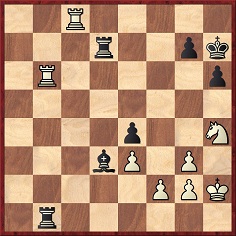
Position after 32...Rb1
Tartakower passed over 33 Re6 without comment, but in a letter on pages 329-330 of the December 1956 BCM Edgard Tchélébi of Beirut pointed out an immediate win for White with the ‘simple, but brilliant, move’ 33 Ng6, followed by 33...Rxb6 34 Nf8+ Kg8 35 Nxd7+ Kh7 36 Nxb6. Tchélébi concluded:
‘Really, an unbelievable treble chess blindness since neither Dr Rey (when playing 32...R-QKt8) nor Dr Tartakower (when answering 33 R-K6) nor still Dr Tartakower (when analysing the game) suspected this brilliant possibility.’
9019. Tartakower v Rey Ardid, Sitges, 1934
On 25 May 1934 Tartakower lost a miniature to Rey Ardid in the first round of the Sitges tournament: 1 d4 d5 2 c4 e6 3 Nf3 Nf6 4 Nc3 c5 5 cxd5 Nxd5 6 g3 cxd4 7 Nxd4 Nxc3 8 bxc3 e5 9 Nb5 Qa5 10 Qd5 Nc6 11 Rb1 Be6 12 Nd6+ Bxd6 13 Qxd6 Rd8 14 Qa3
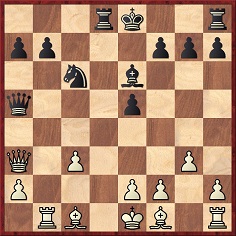
14...Nd4 15 Qb2 Bf5 16 Bd2 Nc2+ 17 Kd1 Na3 18 Qb4 Qd5 19 Rb2 Qxh1 20 White resigns.
Rey Ardid annotated it on pages 41-42 of his book Cien nuevas partidas de ajedrez (Saragossa, 1940), concluding that it was one of his best games:
‘Esta bonita miniatura, que ha sido publicada en revistas y crónicas de todo el mundo, es una de las mejores partidas del autor del presente libro.’
He had given a briefer set of notes on pages 189-191 of Los principios del ajedrez (Saragossa, 1939).
Tartakower annotated the game in depth on pages 984-986 of L’Echiquier, March-April 1935. His final remark was:
‘Quelle débâcle!’
9020. Hastings
These photographs have been submitted by Olimpiu G. Urcan (Singapore):
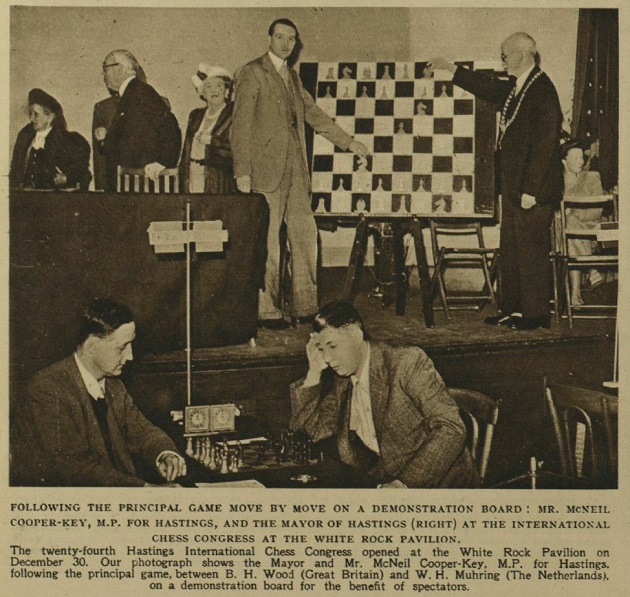
Illustrated London News, 8 January 1949, page 52
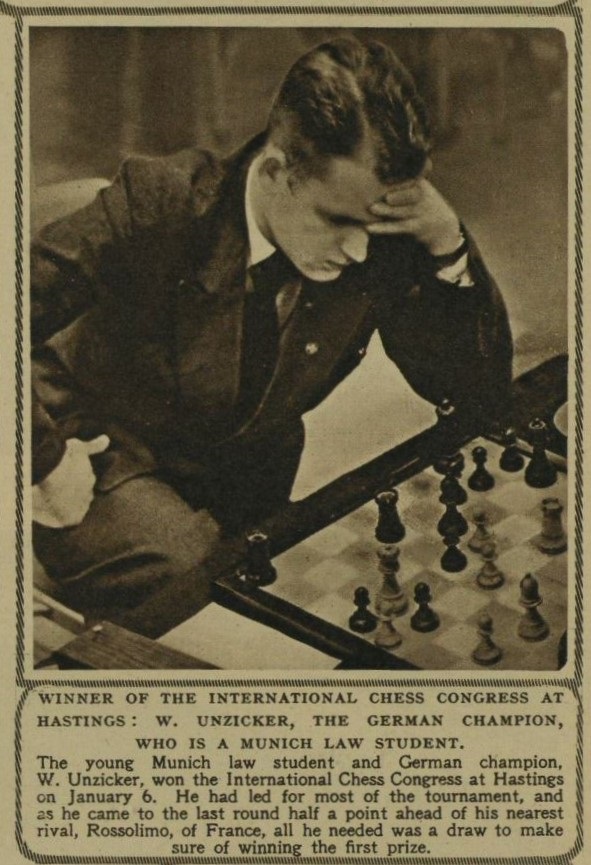
Illustrated London News, 13 January 1951, page 46
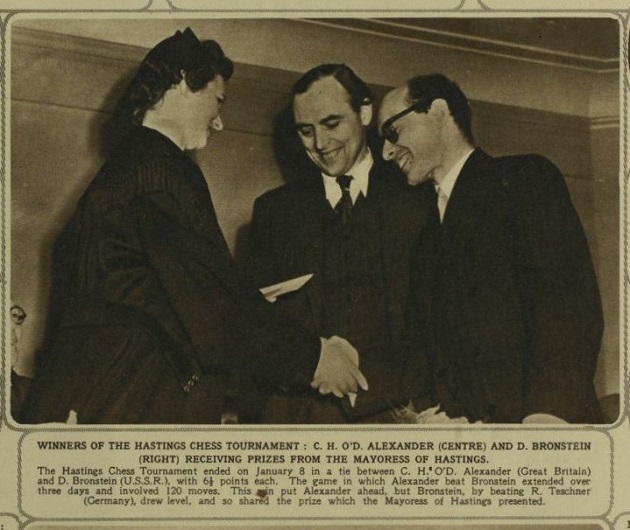
Illustrated London News, 16 January 1954, page 93
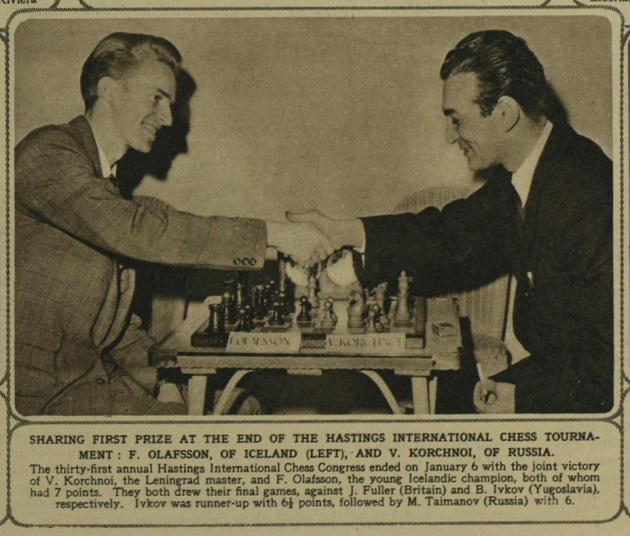
Illustrated London News, 14 January 1956, page 63
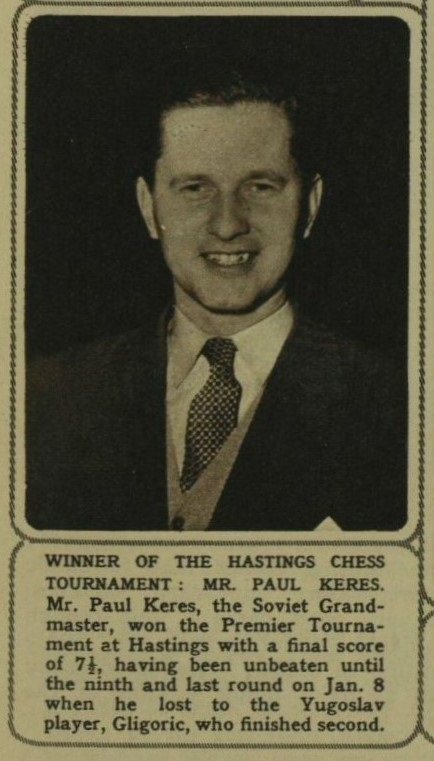
Illustrated London News, 18 January 1958, page 105
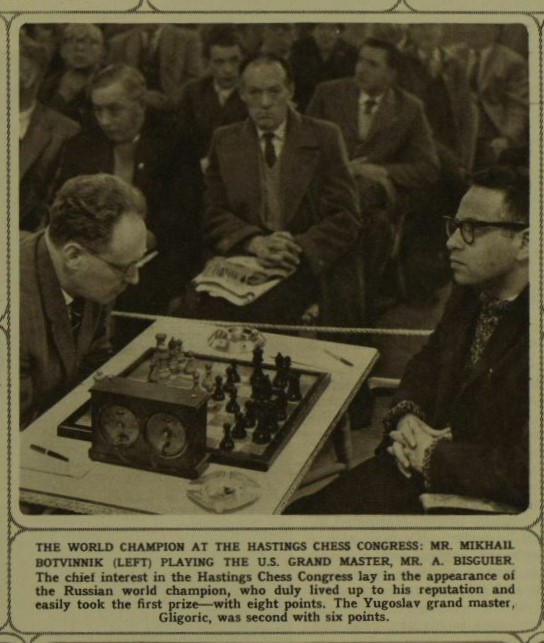
Illustrated London News, 13 January 1962, page 69
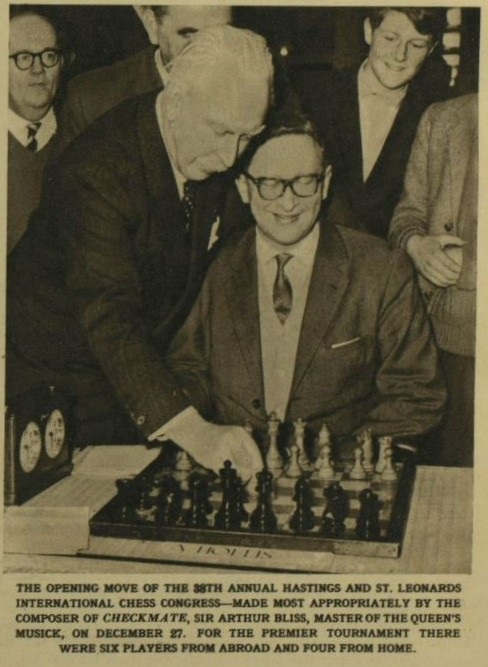
Illustrated London News,
5 January 1963, page 5 (Vassily Smyslov)
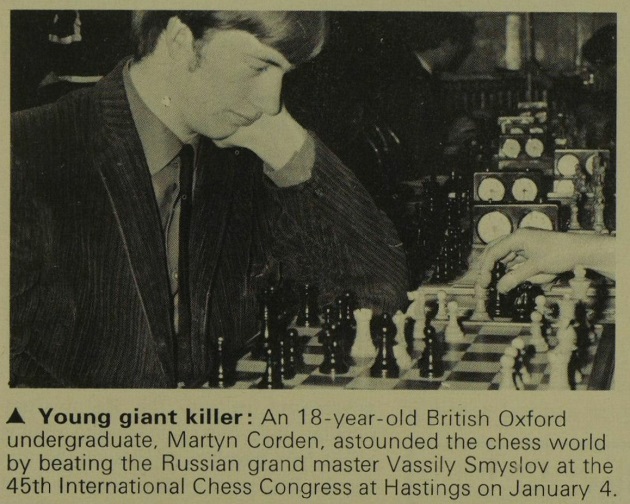
Illustrated London News, 10 January 1970, page 7.
9021. Thomas v Capablanca, Ramsgate, 1929
Dominique Thimognier (Fondettes, France) has found this photograph on page 8 of the Czech publication Pestrý týden, 27 April 1929:
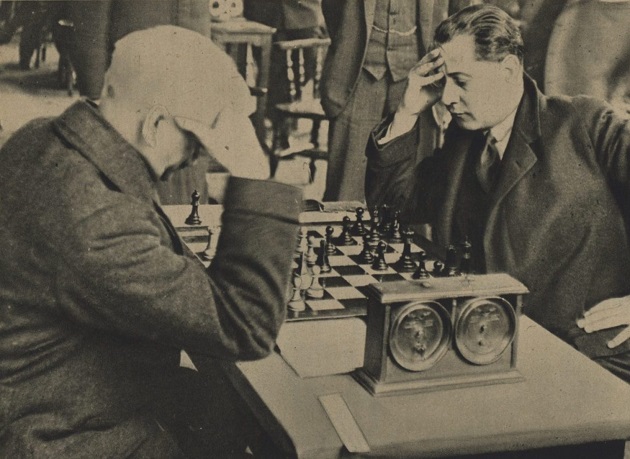
9022. A party trick
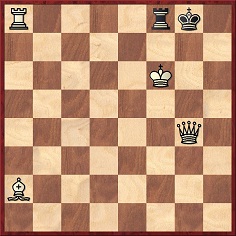
White gives mate without making any move.
The solution will be given in due course, but readers not wishing to wait will find the problem in the ‘Party Tricks’ chapter of Leonard Barden’s Chess Puzzle Book (London, 1977).
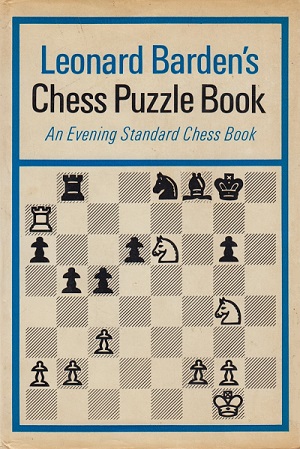
Further to C.N. 8979, Mr Barden informs us that the Evening Standard has now agreed to prolong his chess column for a month, until the end of January 2015, to give time for a longer-term solution to be sought.
9023. Baarn, 1944
Harrie Grondijs (Maastricht, the Netherlands) has
forwarded this cutting from De Telegraaf, 17 May
1944, concerning the tournament in Baarn:
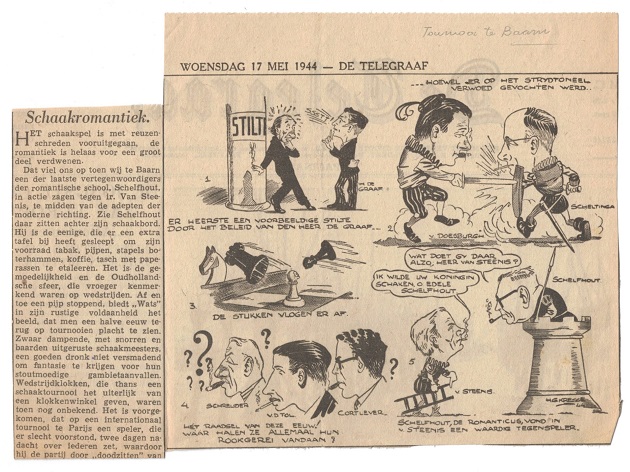
Our correspondent has translated the captions:
1. ‘There was exemplary quietness enforced by Mr De Graaf ...’ 2. ‘... although on the battleground some heavy fighting was going on.’ 3. ‘The pieces flew all around.’ 4. ‘The puzzle of the century! Where do they all get their smoking gear from?’ 5. ‘What are you up to, Mr van Steenis?’ ‘I wish to abduct your queen, O honourable Schelfhout.’ ‘Schelfhout, the romantic, met a worthy opponent in van Steenis).’
9024. Jeremy Thorpe and Peter Clarke
From CHESS, November 1971, page 37:
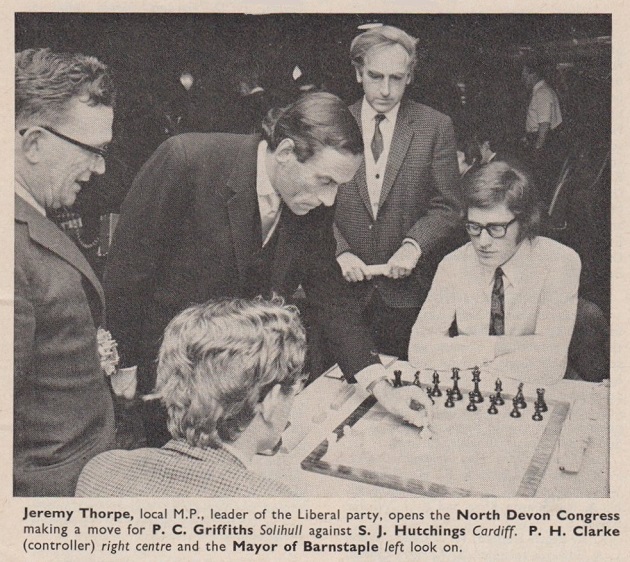
Both Jeremy Thorpe and Peter Clarke died in December 2014.
| First column | << previous | Archives [125] | next >> | Current column |
Copyright: Edward Winter. All rights reserved.